Understanding Artisan's Response To The Ban On Plaster Of Paris Ganesh Idols Survey of artisans in Pune and Pen cities, Maharashtra May 2024
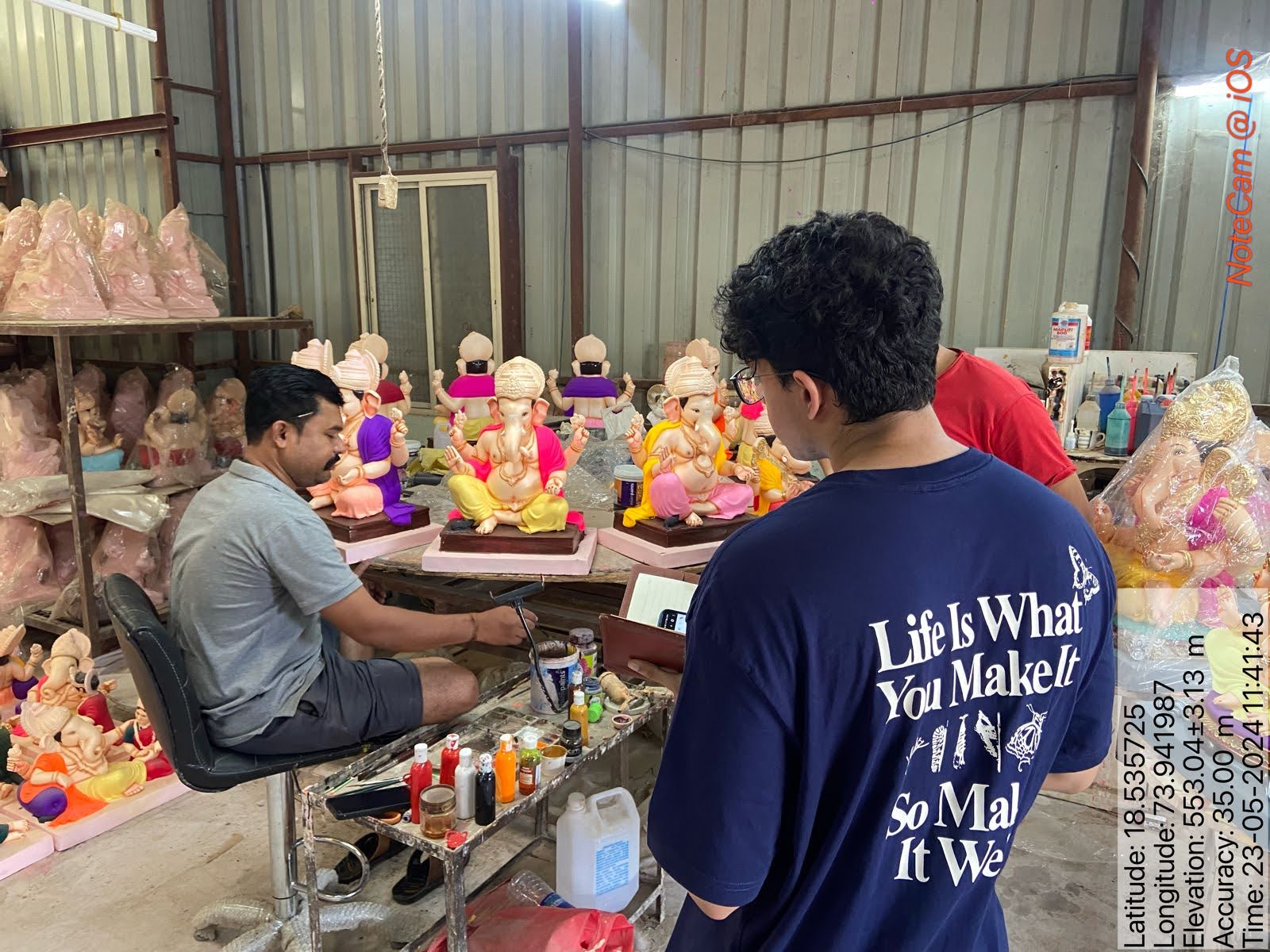
Background
The craft of sculpting Ganesh idols for the festival of Ganesh Chaturthi supports an entire community of artisans across India for whom this is their main source of livelihood. These stunning handmade sculptures are an invaluable part of Indian culture as they form a very important aspect to the Hindu belief system and tradition.
Originally, the artisans used natural and biodegradable materials to sculpt the idols, which are expected to disintegrate at the end of the festival in an immersion ritual called visarjana. In recent times, natural materials have been replaced by industrial materials such as Plaster of Paris and chemical paints, which when immersed into natural water bodies such as rivers and lakes, cause water pollution at a large scale.
Over the past two decades, the environmental impact of these materials has caused much debate in Indian society, pitching the artisanal community against the environmentalists and the government. In 2010, the Central Pollution Control Board issued guidelines for immersion that while recommending the use of non-polluting materials, were not really effective in solving the problem. In 2020, the CPCB then established the Revised Immersion Guidelines with a clear ban on the use of Plaster of Paris for the Ganesh idols.
When writing this paper in June 2024, the government was still unable to implement this ban fully.
This research paper is based on a survey conducted to understand the concerns and challenges of the artisanal community and also to guage their level of awareness and understanding about the ban.
Methodology
- To start with, a secondary source study was done on the internet to look for the concerns or challenges the artisans may have faced with the issuance of the revised guidelines.
- Based on this study, a questionnaire was designed to outline the survey.
- Face-to-face interviews were conducted with artisans in Keshavnagar, Pune, and a first survey of 7 artisans helped us to gauge the willingness and availability of the artisans to speak with us. Rather than going question by question, we led free-flowing conversations with them to put them at ease and pick up further unspoken clues to their concerns.
- A second round of 15 interviews was conducted in Keshavnagar to cover the main producers of Pune city.
- The second phase of the survey was conducted in Pen, the town that still produces the largest number of clay idols. 25 artisans were interviewed here. Each interview lasted between 5 to 10 minutes, depending on the cooperation from the artisan.
- Audio responses were recorded which were then converted to written content later.
- Interviews were conducted in Marathi as their language of choice and then translated into English.
- The questionnaire was cleaned up in phase 3 to separate qualitative and quantitative responses.
The CPCB RevisedImmersion Guidelines (2020)
-
Prohibitions placed by way of Immersion Guidelines mainly dealt with:
- Idols made up of Plaster of Paris (PoP) shall be banned.
- Use of toxic and non-biodegradable chemical dyes/oil paints for painting idols should be strictly prohibited.
- Use of Single use plastic and thermocol materials shall not be permitted
- Restrictions on height of the idol
- Avoid direct immersion of idols into lakes/rivers/ ponds/sea.
- Only non-recyclable/non-biodegradable/non-recoverable materials should be disposed of in sanitary landfills
Overall Assumptions
- The Ganesh idol industry is mainly dominated by men – gender was not taken into consideration in the survey. ( mention how many women answered the survey
- The context of artisans in Pune city – which is a major tier 2 city is different from the artisans in Pune which is a much smaller city – this contextual difference has not been considered in comparing the responses
- As there has been growing resistance to the ban, we approached the interviews in a neutral way without a prejudice for or against the legislation to win the trust of the artisans and listen without prejudice.
- The assumption we began with was that the ban is perceived as a threat to livelihood and this is the major cause for resistance.
- The traditional material used in Pune and Pen has been natural clay which got replaced by Plaster of Paris. The study is therefore primarily focussed on these two materials and the preference of the artisans for these.
Overall Findings
-
- There is a major confusion as to the true environmental impact of both clay as well as Plaster of Paris among the artisans. Their sources of knowledge about this are limited to the unions they may be a part of or what they see on the internet. Awareness about the materials impact is very low.
- Awareness of the specifics of the ban is also low and there is no clear communication or active engagement from the government on this matter.
- The craft is very much alive and most artisans are expecting a growth in the industry and wish to remain engaged with this profession. Younger generations are also getting involved even though some now are exploring other professions alongside as this is a seasonal activity.
- The artisanal community does not take responsibility for the pollution created by the materials they use – this is either due to lack of awareness about or a denial of the environmental impacts of POP.
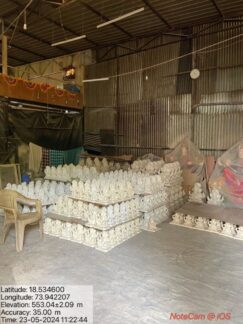
The Questions
The first three questions are name and contact details
Q4: How many years have you been an artisan? (47 responses)
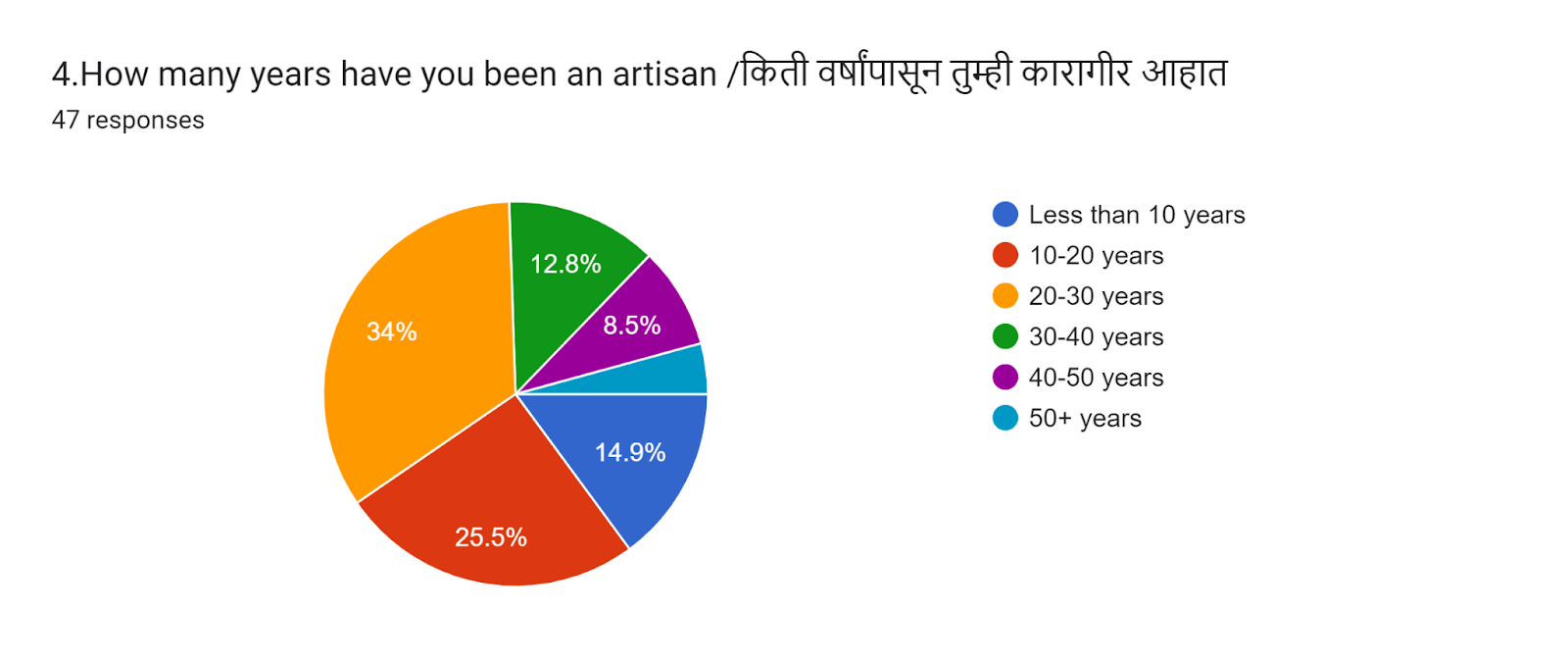
Assumptions: As India gets more and more urbanised and tech savvy, few people want toc ontinue with labour intensive hand made crafts . This question was to check the demographic and the continuity of the craft over generations. Also, it was assumed that older artisans may not be open to change as much as younger artisans .
Findings: Only 15% are recent artisans, the majority of them have been working on this between 10 to 30 years. The debate on POP started as early as 1995 and so it has been in public dialogue for the past two decades at least. Recent artisans are likely more aware of the ban issue.
Notes from conversations: Out of the 3 artisans who were against the ban, two of them had been an artisan for 30-40 years while one artisan had been for 10-20 years.
Q5: Is this your main profession? (47 responses)
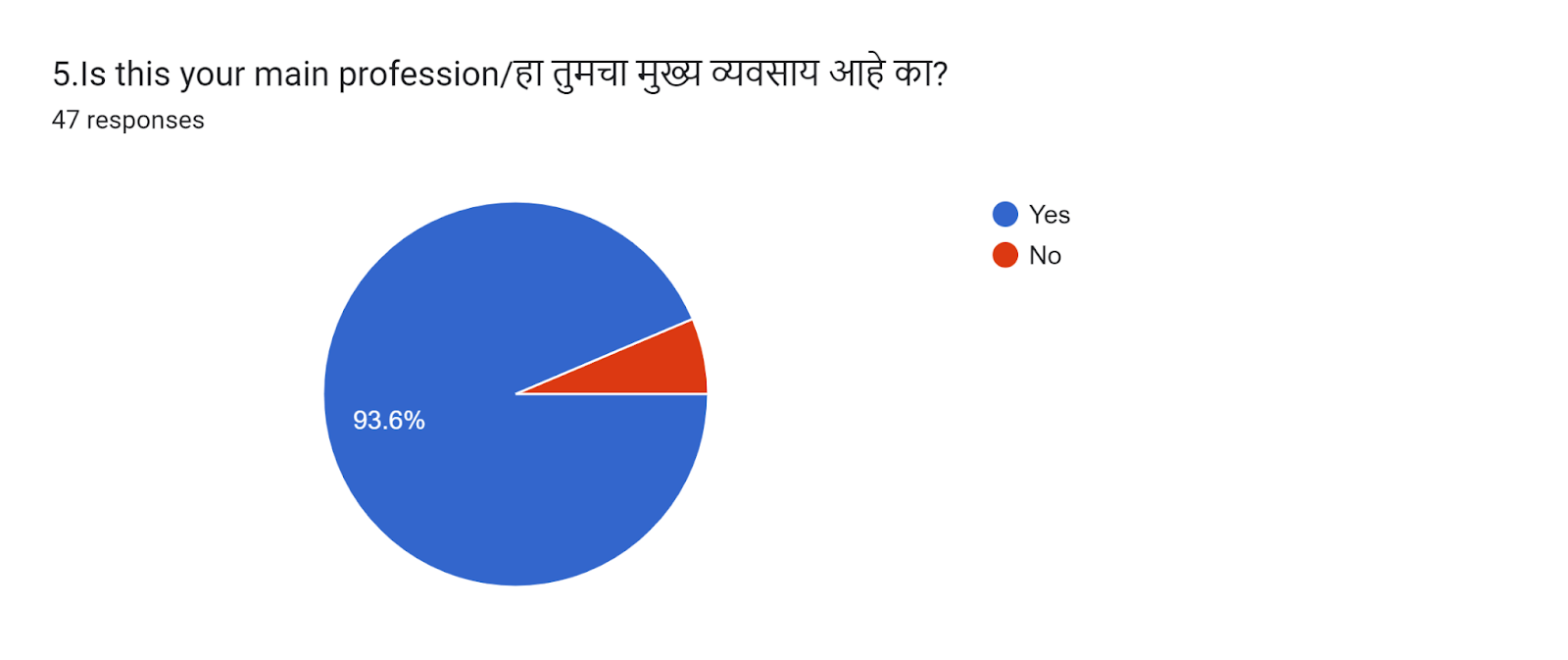
Assumptions: If the artisans has only this one source of income they would be more resistant to change as it threatens their main livelihood
Since this is a seasonal occupation, often people will only do this during the season and alongside other work
Smaller artisans may not be able to cover their annual expenses with one activity alone
Findings: 93.6% are mainly artisans – this means that their scale of production is large enough to sustain them year-round
Q6: If not, what other professions do you have? (3 responses)
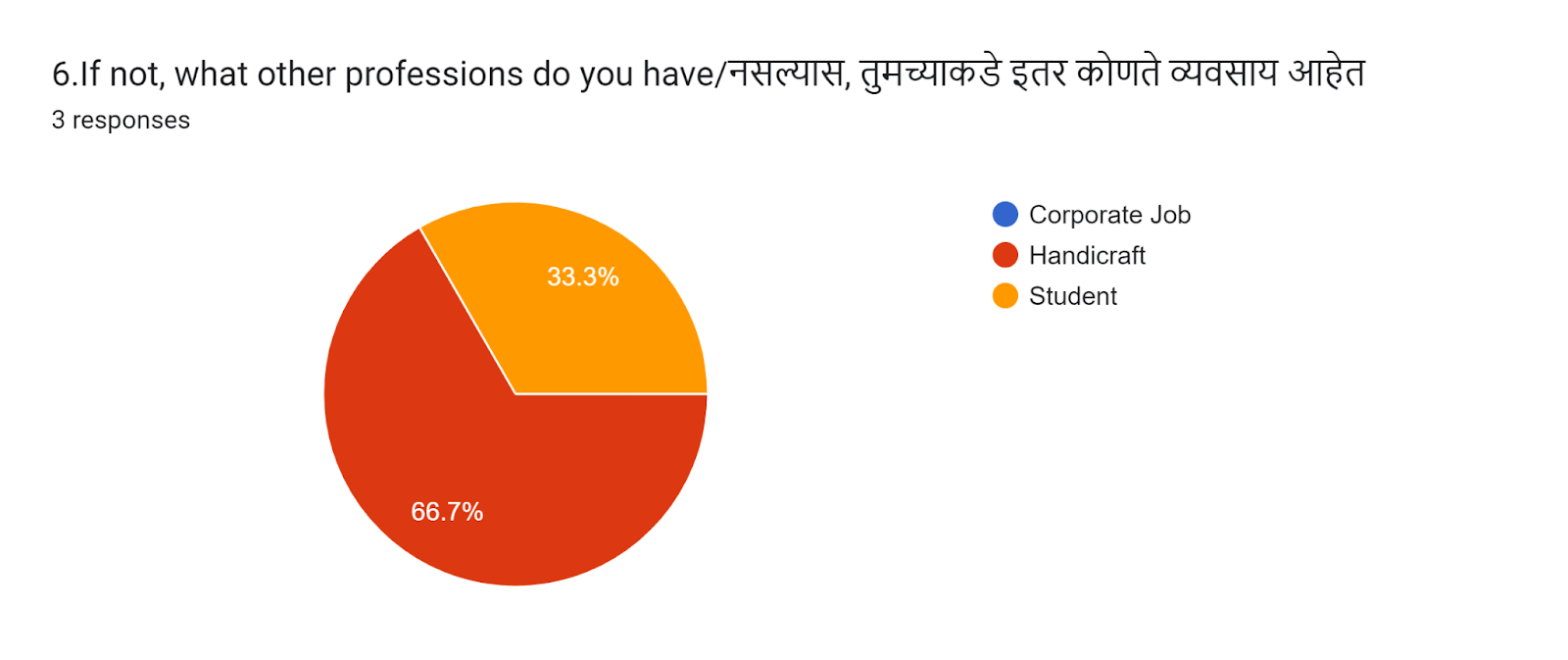
Assumptions: There is a trend of a shift from handwork to corporate office jobs
Findings: Younger generations are still trying to hold on to the tradition while juggling other jobs too. Those with other jobs were working mainly in the handicraft industry only.
Q7: Is anyone else in your family in this profession? (47 responses)
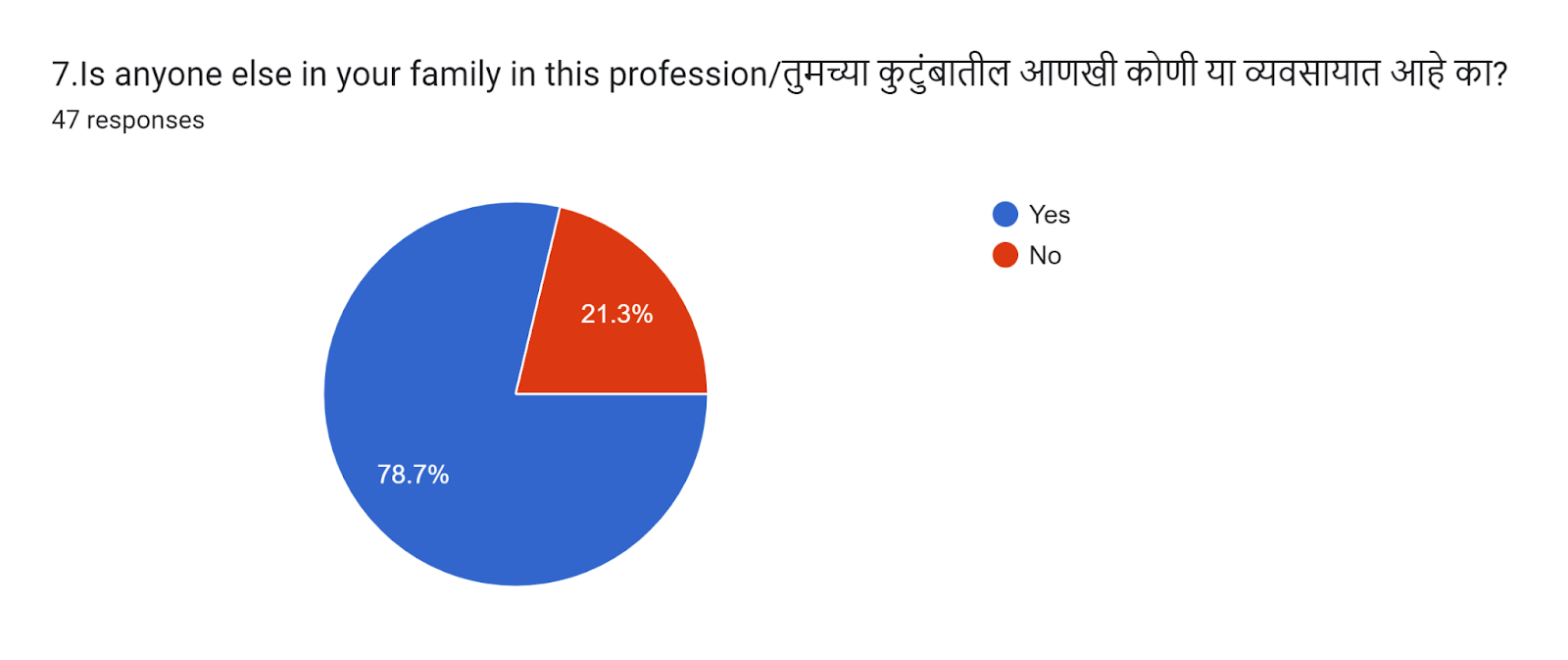
Assumption: The smaller scale artisans will need help from family members whereas the larger scale producers hire labour
Findings: Most workers had one or more family members in the same profession. A theme that this was a familial job emerged. In contrast to Pune, where the majority had family members also involved, Pen had more artisans who were the sole members of their families in this line of work. 21 artisans from Pune had other family members working with them, whereas in Pen only 14 of them had family members working with them. Idol making is THE main occupation of residents of Pen and so it is almost like an industry for which they hire labour. The cost of labour has increased steadily over the past years and therefore material like clay which needs more labour than POP are not as popular.
Q8: Are you from Pune or another city ? ( Are you a local resident or do you come from another location?) (47 responses)
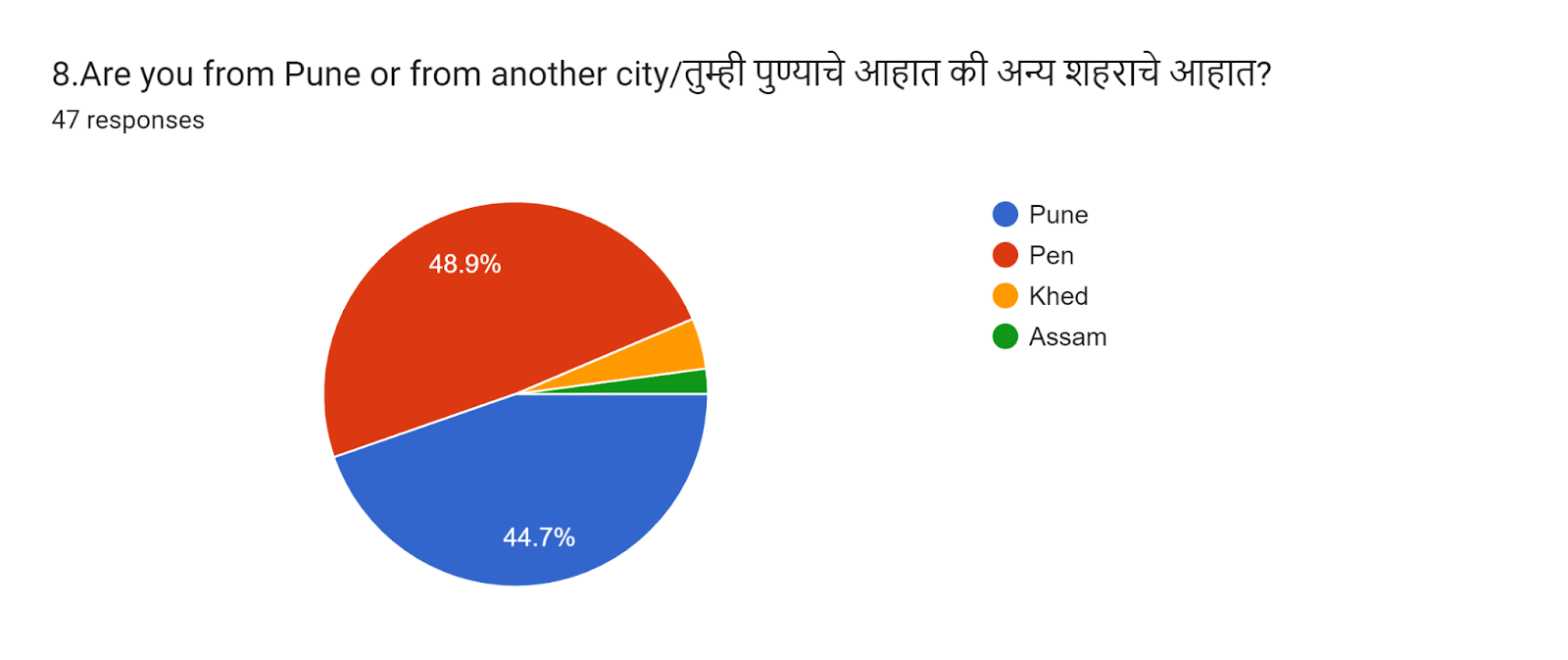
Assumptions: Migrant populations who may be farming etc come to larger cities for a few months to look for work and return to their villages after the season – these may be unaware of the local laws and regulations.
Findings: Out of the 24 artisans interviewed in Pune, only 3 were migrants/from out of Pune. In Pen, out of the total 23, only one artisan was from out of town.
Notes: If the artisans are local residents then it is possible for the government to set up a system of registration and regulation as it is not a migrant shifting population. Such a system would also allow the government to provide incentives and track the shift of materials used.
Q9: How much do you earn from this activity? (47 responses)
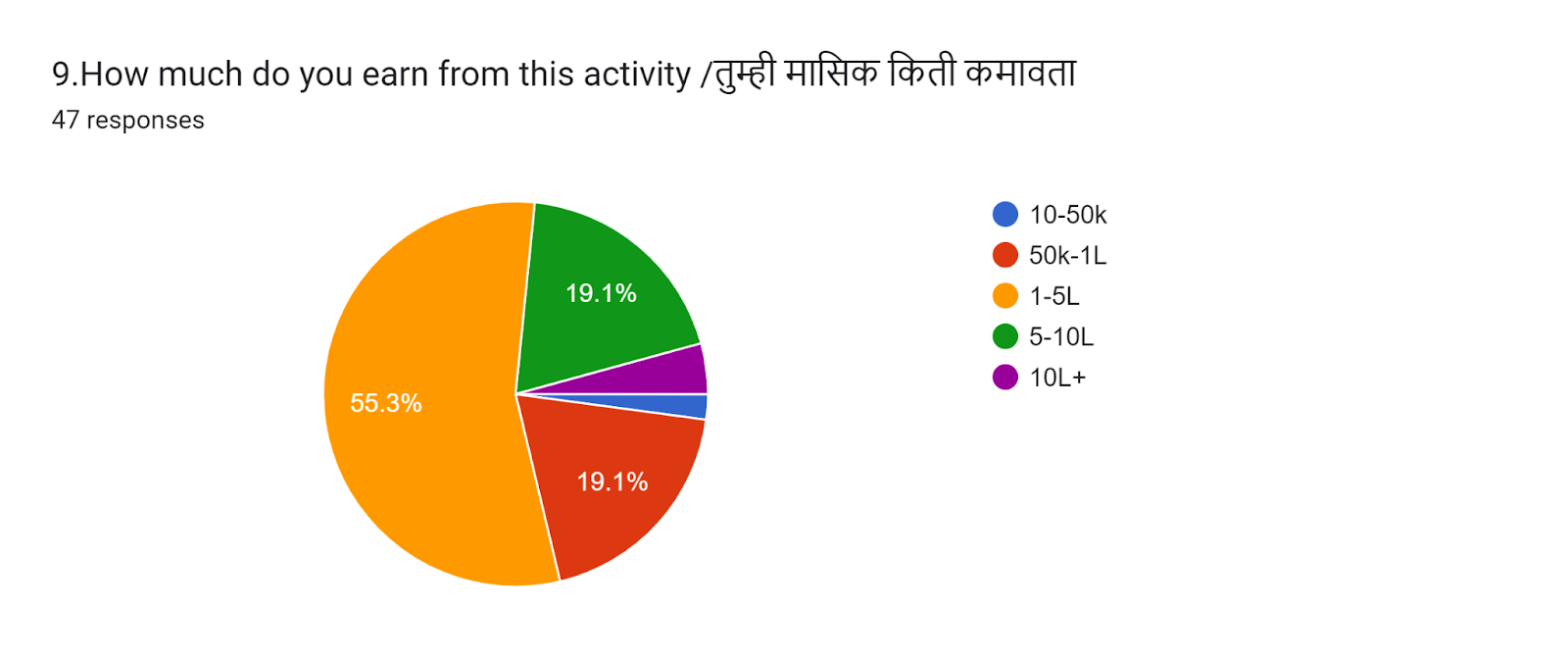
Assumptions: The profitability of this handicraft small scale industry was in question – in a rapidly modern and high tech world – does this craft continue to sustain the artisans ?
Findings: Most artisans made enough revenue to sustain them through the year, with many being in the 1-5 Lakhs bracket. Very few artisans made below 50 thousand.
Notes: Since this craft and industry is based on a deeply sentimental and religious belief system, the likelihood of it becoming obsolete is low. Prices of Ganesh idols have steadily increased in the market and the consumer base is steady and growing.
Q10: What material are the majority of your models made of? (47 responses)
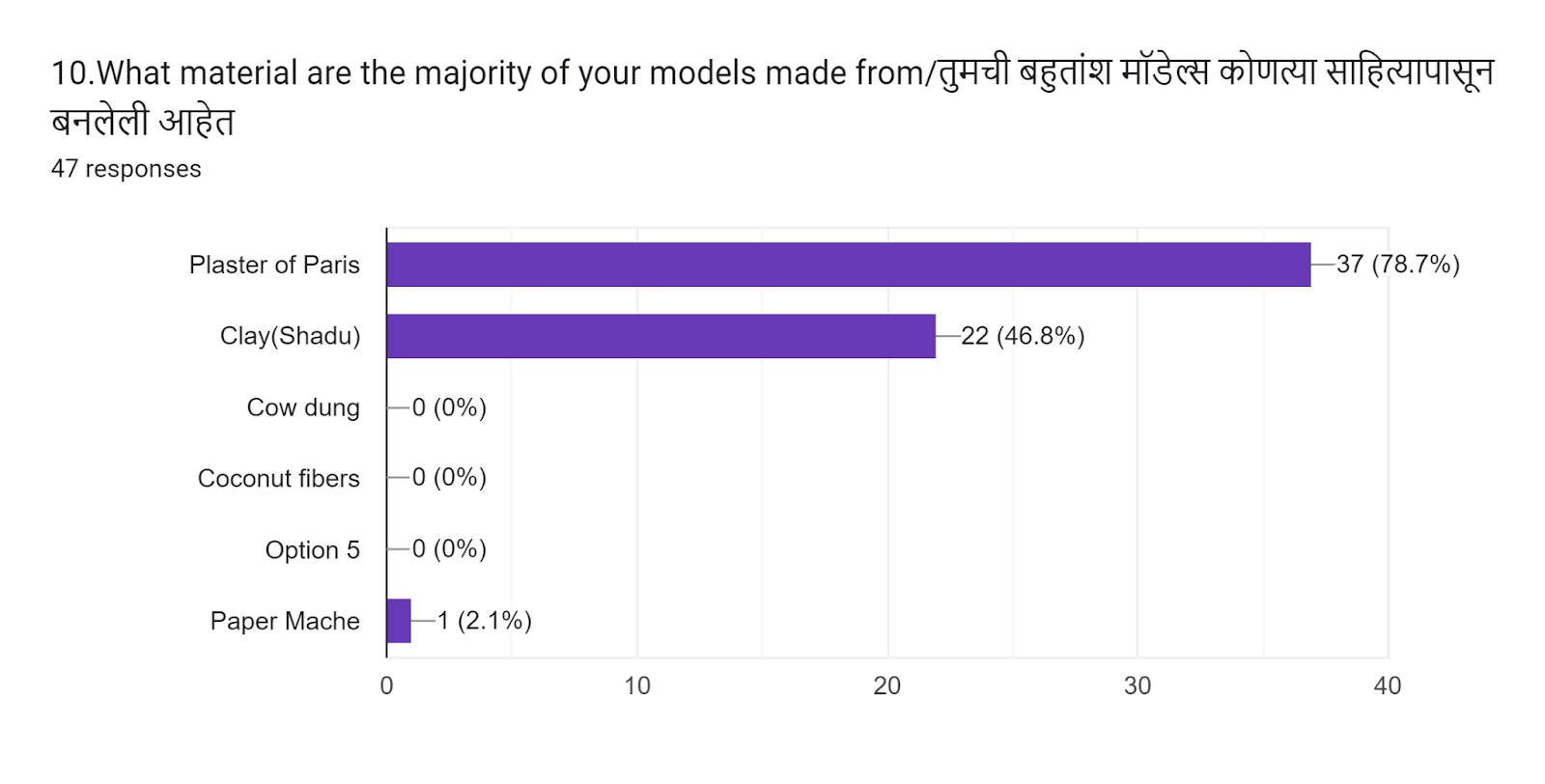
Assumptions: The research assumed that as the debate around POP continues, the artisans would slowly start exploring other options.
Findings: Plaster of Paris has a clear dominance over other materials. A total of 25 artisans were working with just Plaster of Paris, 9 were working with only clay, 12 were working with both Plaster of Paris and Clay, and one artisan was working with paper mache as well. A major point to note is that there is usage and awareness about only two main materials in the market.
Other eco friendly alternatives such as cow dung and paper mache are not yet considered a viable option.
Q11: Why have you chosen this material? (47 responses)
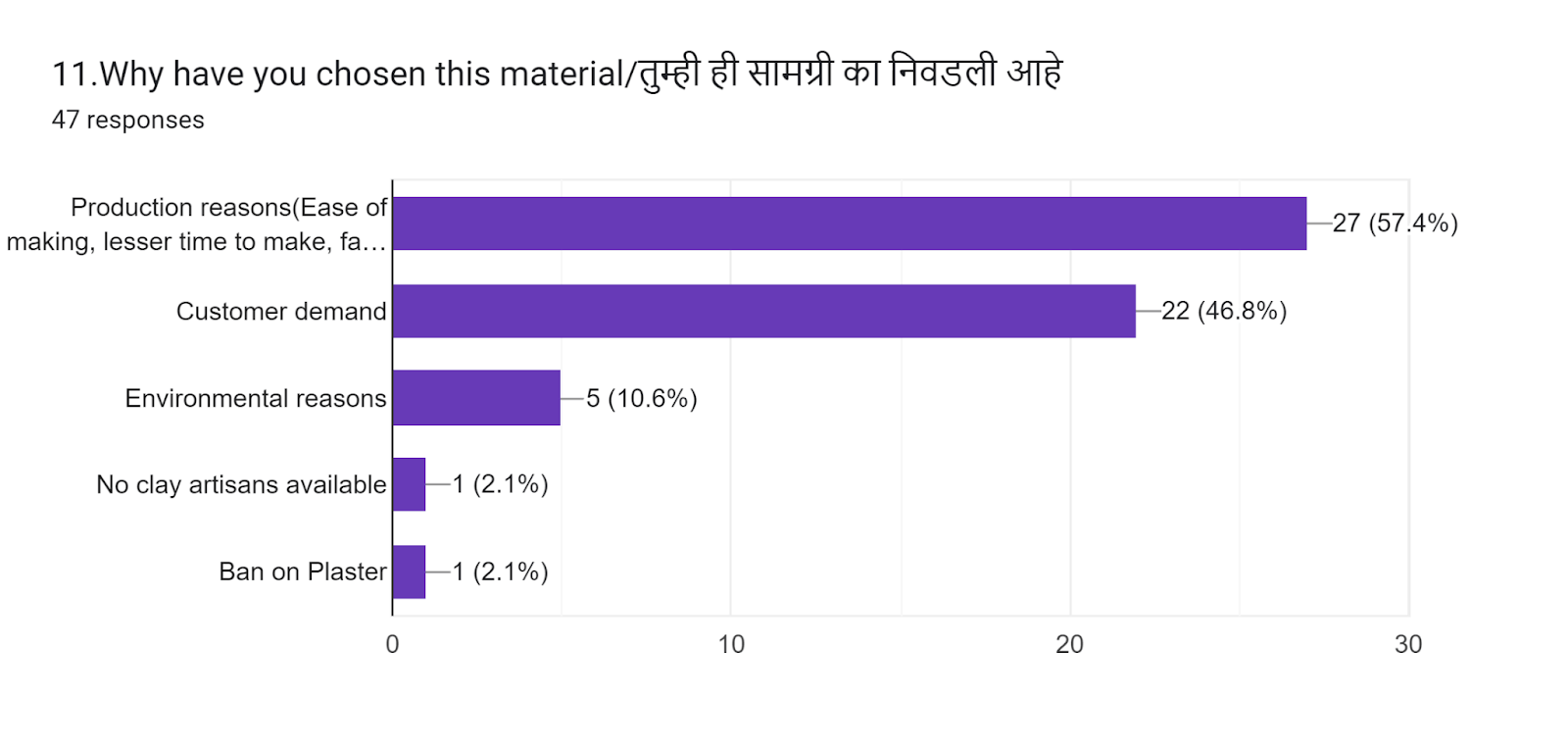
Assumptions: The cost factor was assumed to be the main aspect governing the preference for POP.
Findings: Artisans using PoP were mainly using it as it is much easier to produce. It is quicker, lighter, durable, and easily fixable. Another major reason for choosing whichever material was that the artisans simply catered to what the customers were asking for.
Notes: Artisans using clay had a general awareness of the effects of PoP. Those using clay also stated that they do not have an issue with clay, but the customers themselves are demanding Plater of Paris models.
Q12: Do you think this material is good for the environment? (47 responses)
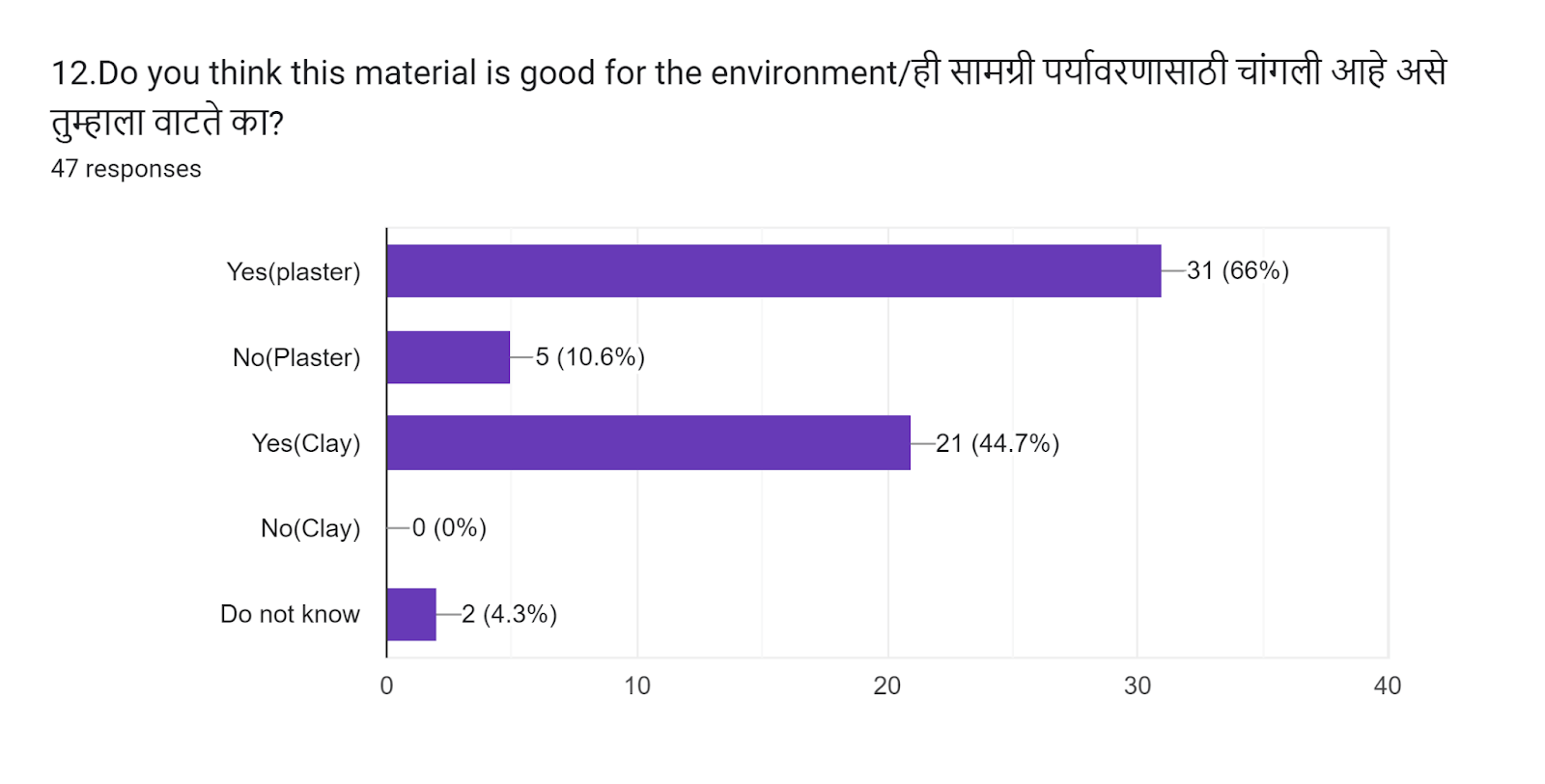
Assumption: When the loop of production and consumption is local – artisans are living in the same environment as their clients and both parties are aware of the impacts to their local environment. As the craft grew into an industry and the radius of sale increases, the artisans do not feel responsible for the impact their products have on the ultimate place where it is used and imemrsed. This question was an attempt to guage who much ownership the artisans feel toward environmental protection.
Findings: The majority of the artisans believed that Plaster of Paris was completely safe for the environment. Only a small number of people said that Plaster of Paris was harmful, and none said that clay caused any harm to the environment.
Q13: Why do you think so? (47 responses)
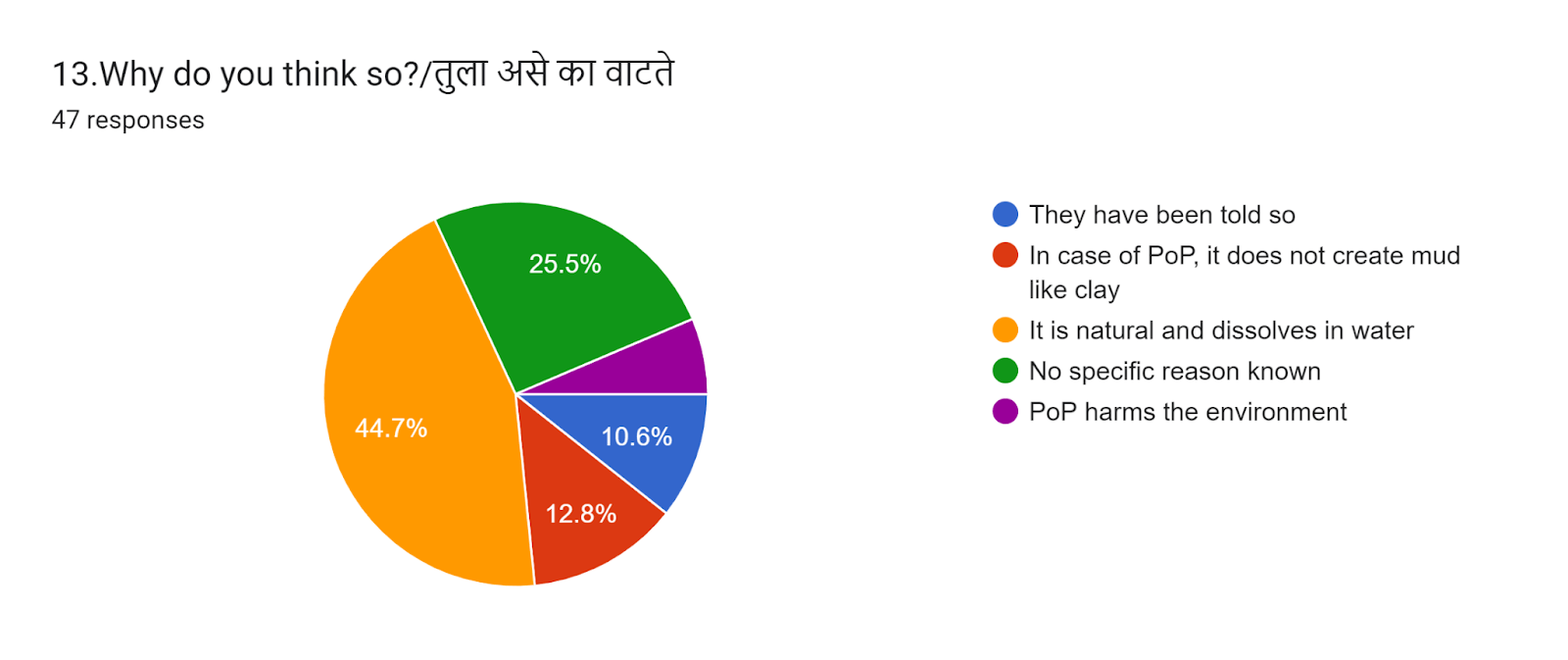
Text content
Assumptions: The artisans are being heavily influenced by the sanghatnas and all their information is coming through them ( inspite of the fact that the majority of them are not a part of the unions)
Findings: Majority of the artisans using Plaster of Paris believe that PoP is good as they have been told so by various sources. About 12 percent said that it is better than clay as well. 44 percent of people think that clay is good as it dissolves in water. Very few said that PoP is not good for the environment. An important point is that a majority did not have any reason for their beliefs, indicating accepting information blindly as well as a certain amount of ignorance.
Notes: Some artisans even claimed that research has proven that PoP does not harm the environment and that it may be better than clay.
Q14: Are you aware of the ban on Plaster of Paris? (47 responses)
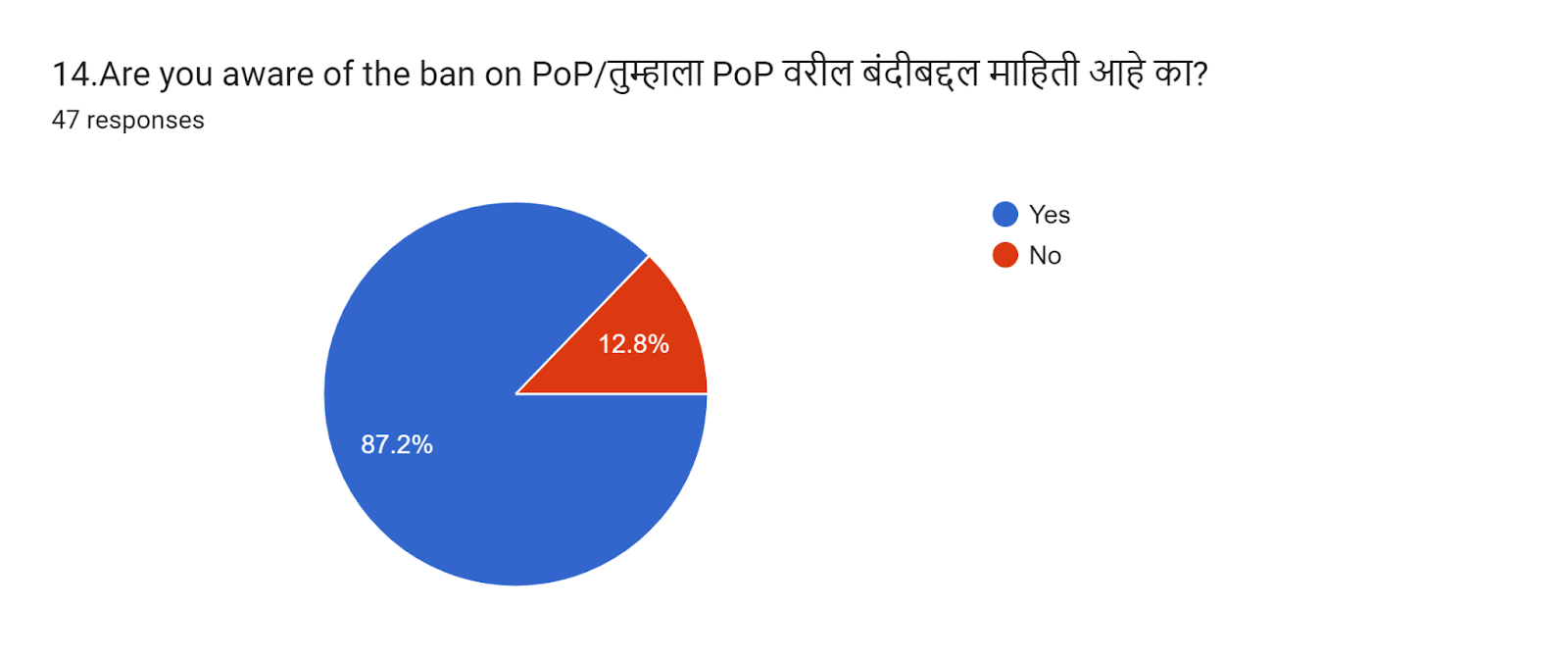
Assumption: Now that it has been 4 years since the Revised Guidelines were established, we assumed everyone would be aware that there is a ban in place.
Findings: Artisans who were aware of the ban were in the majority, while very few did not know about the ban.
Q15: What do you know about the ban on POP? (47 responses)
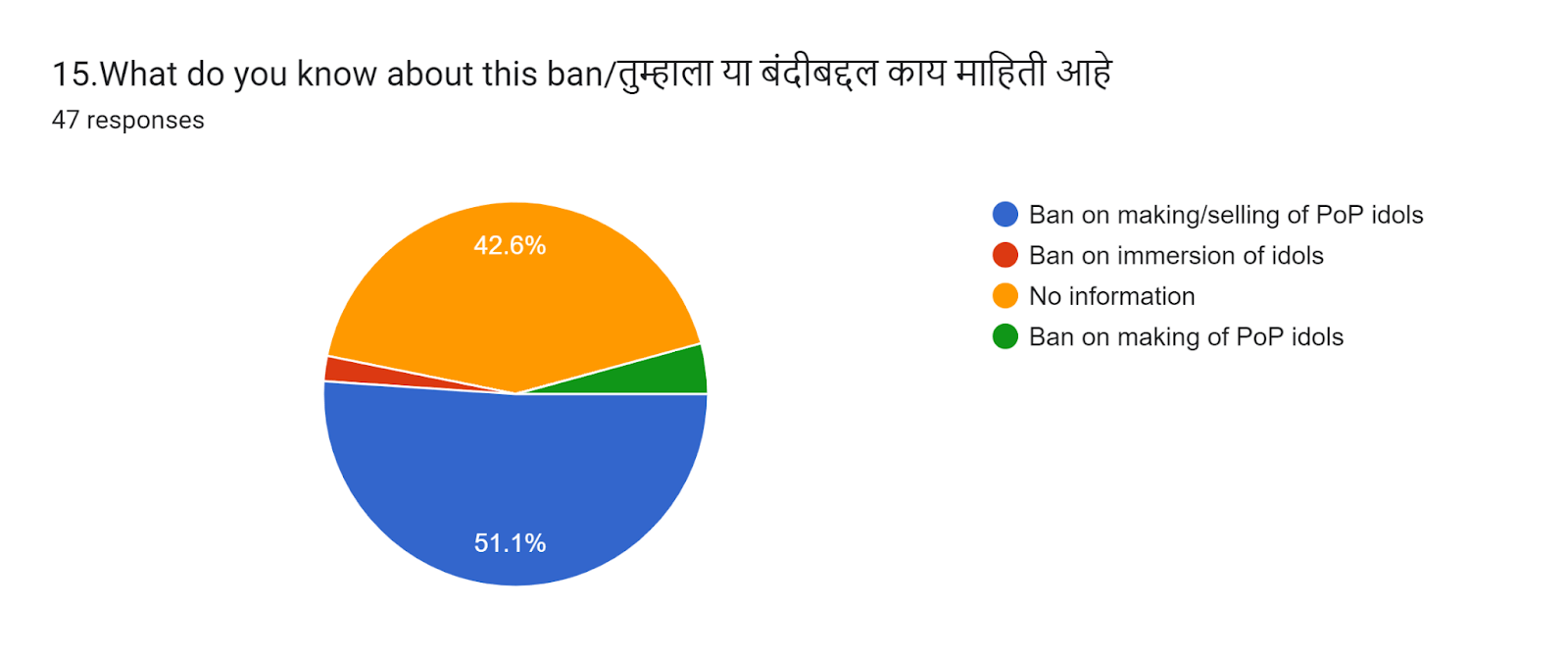
Assumptions: Communication of the ban by the government has to reach the community producing the POP idols – we assumed that the government would have taken steps to ensure that it was clearly communicated.
Findings: There is a large misunderstanding about the specifics of the ban. The consensus is that the ban is on the making/selling of PoP idols rather than what it is actually on, i.e., immersion of PoP idols. Another point is that almost 50 percent of the artisans interviewed had no information on the ban.
Notes: The indication here is that the government is failing to inform the artisans, who will be most affected by it, about the true intention of the ban, creating a misunderstanding.
Q16: Are you in favour of this ban? (47 responses)
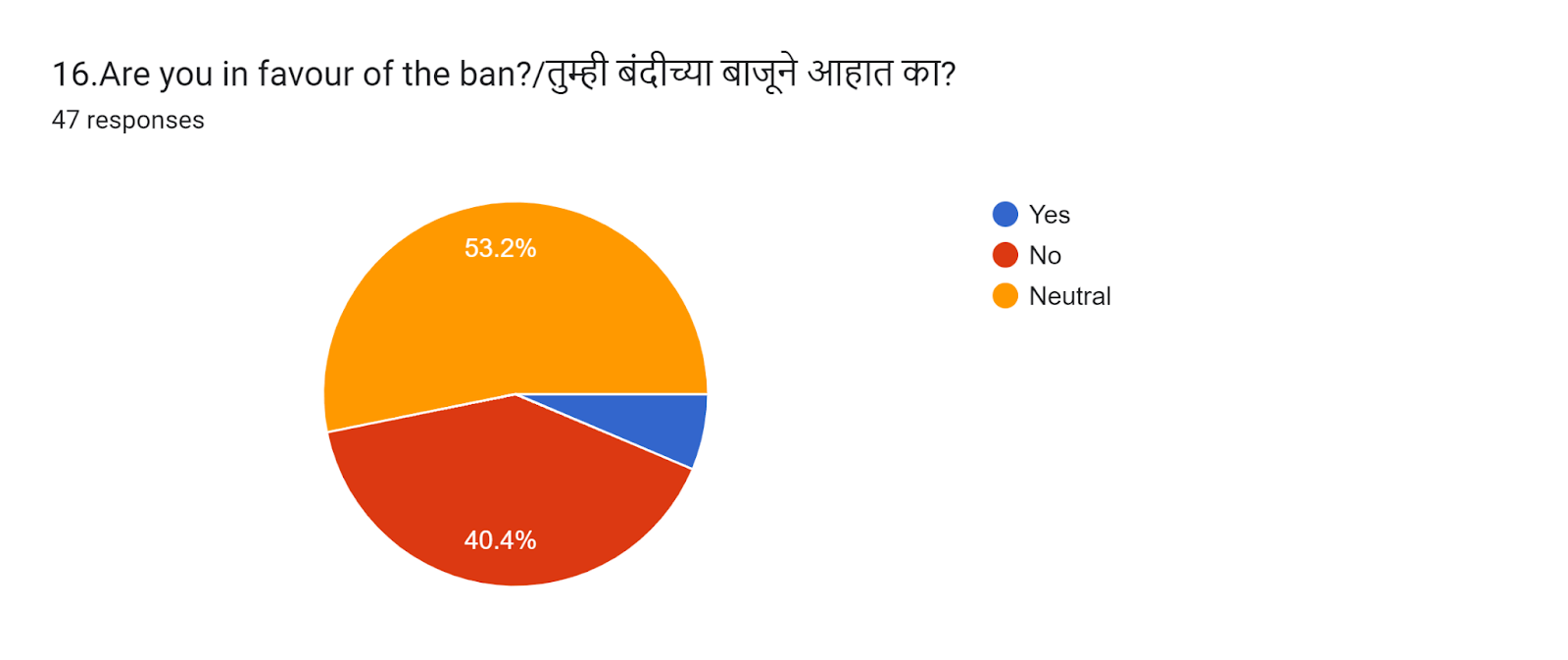
Assumptions: Legislation in India is usually politicized by leaders pursuing vote banks. In the past, city authorities who have taken a strict stand on the ban have had to face the ire of the Ganesh devotees or the artisans or both. This has made the government reluctant to impose stricter restrictions in some cities.
Findings: Most artisans are neither in favor nor against the ban. These are artisans who are mostly using both PoP and clay. About 40 percent of artisans are against the ban as it would hurt their incomes and disrupt their livelihoods. Very few artisans are in favor of the ban.
Notes: Artisans using both PoP and clay are less concerned about the ban. Relating to the awareness about the ban, these also form the majority of those unaware of the ban as it does not concern them. There is correlation to question 15 as well that, since most are unaware about the specifics of the ban, a large number are neutral towards it.
Q17: Has the ban affected you in any way? (47 responses)
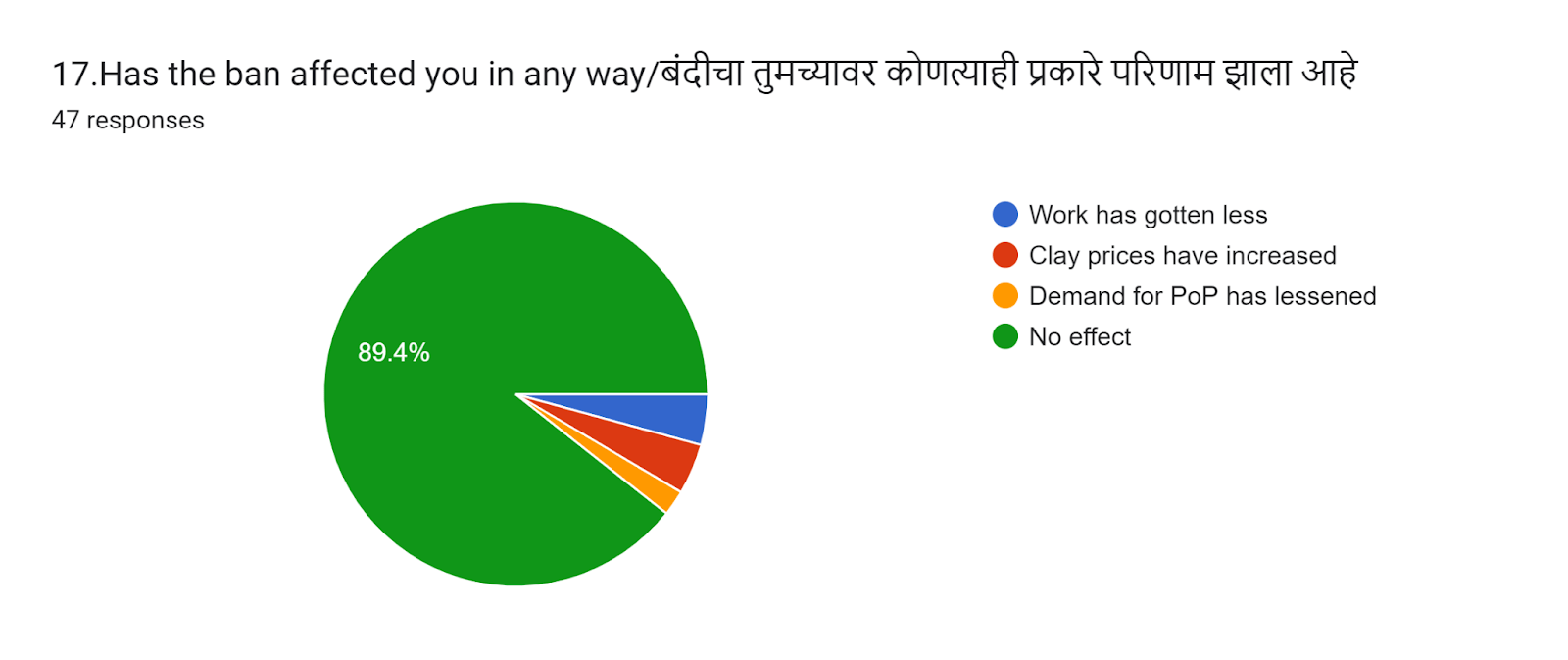
Assumptions: The ban on POP would have majorly affected the artisans which is why they are resisting it.
Findings: Almost none of the artisans were affected by the ban
Notes: This relates to the fact that the government has not made any checks on the artisans and indicates improper implementation.
Q18: Do you know what the effects of POP are on the environment? (47 responses)
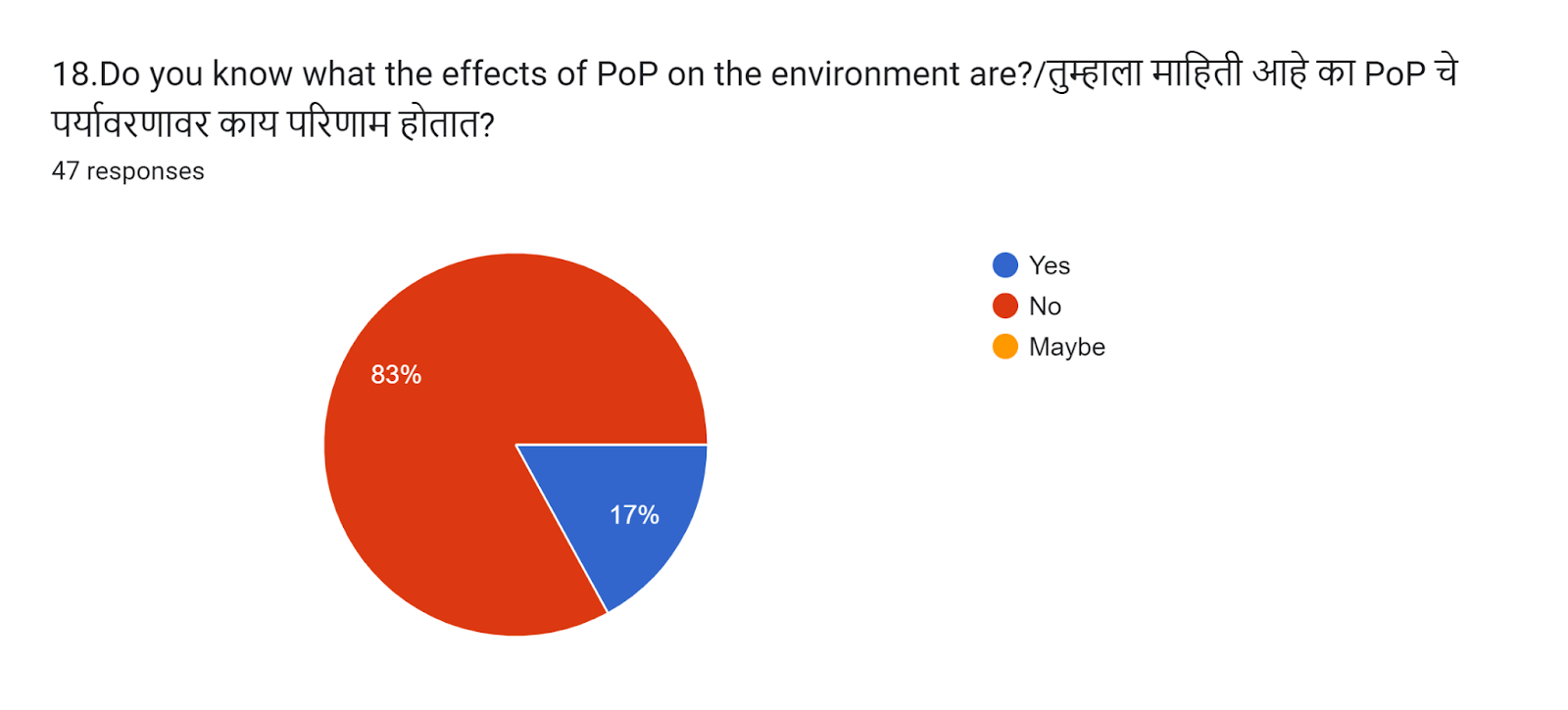
Assumptions: When working closely with a material for a long time, an artisan usually gets a sense of the impacts that material may have either on the human body or on the immediate environment they work in. Especially industrial materials like POP which have a chemical reaction have significant and visible impacts, eg, heat release during the reaction. Even if the artisans may have observed these, whether they understand the larger implications of the material on natural resources such as rivers and lakes needs to be understood.
Before the government prohibits the use of any material for any specific purpose, it has an obligation to take into consideration the implications of such a ban and mitigate its negative impacts. The levels of awareness of the artisanal community would also reflect the efforts put in by the government to help them understand the rationale behind the ban.
Findings: 83 percent of the artisans were unaware of the effects of PoP on the environment.
Notes: There is a large gap in the artisans’ information on the effects of PoP.
Q19: Could you elaborate? (11 responses)
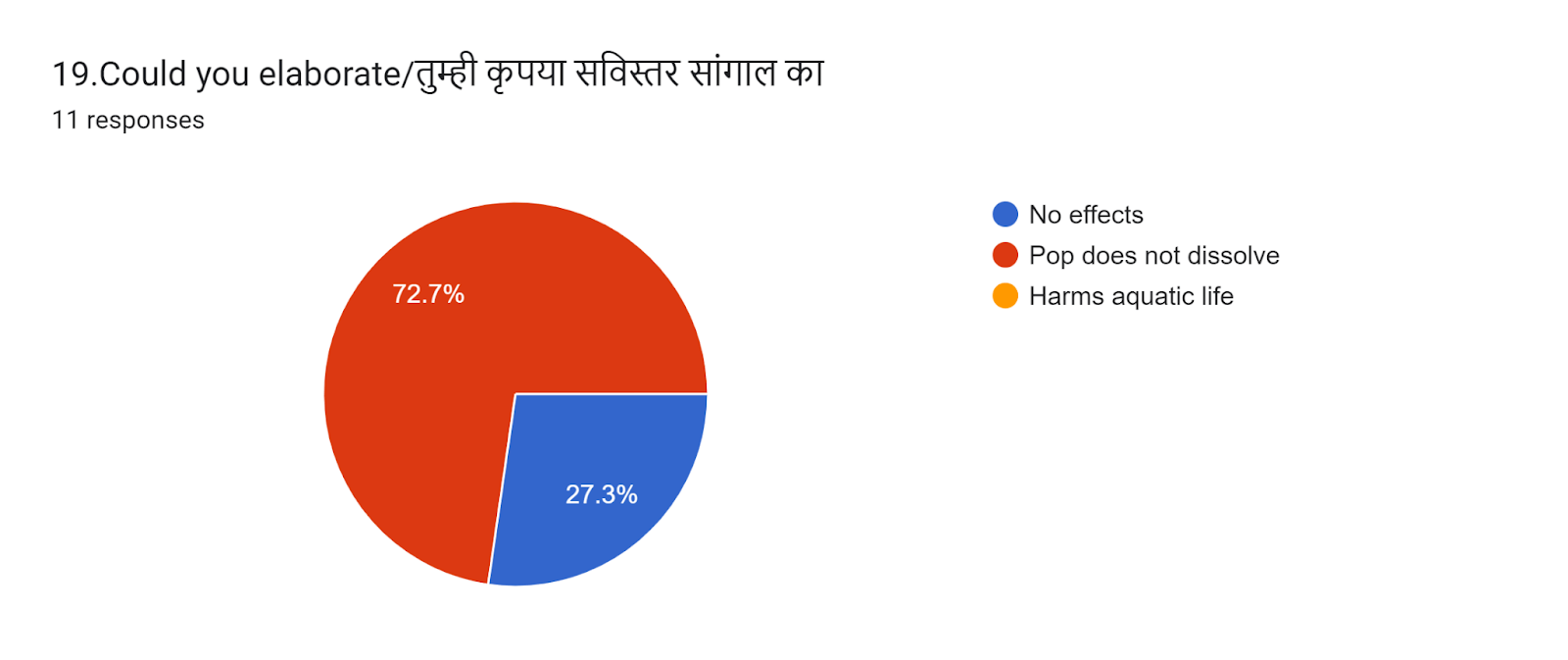
Findings: Out of the people who said yes, some said that PoP does not dissolve once it goes into the water, while a few claimed it also had no effects.
Notes: Some even claimed that PoP had no effects on the environment and was safe to use, correlating to why they use this material.
Q20: What kind of paints do you use? (47 responses)
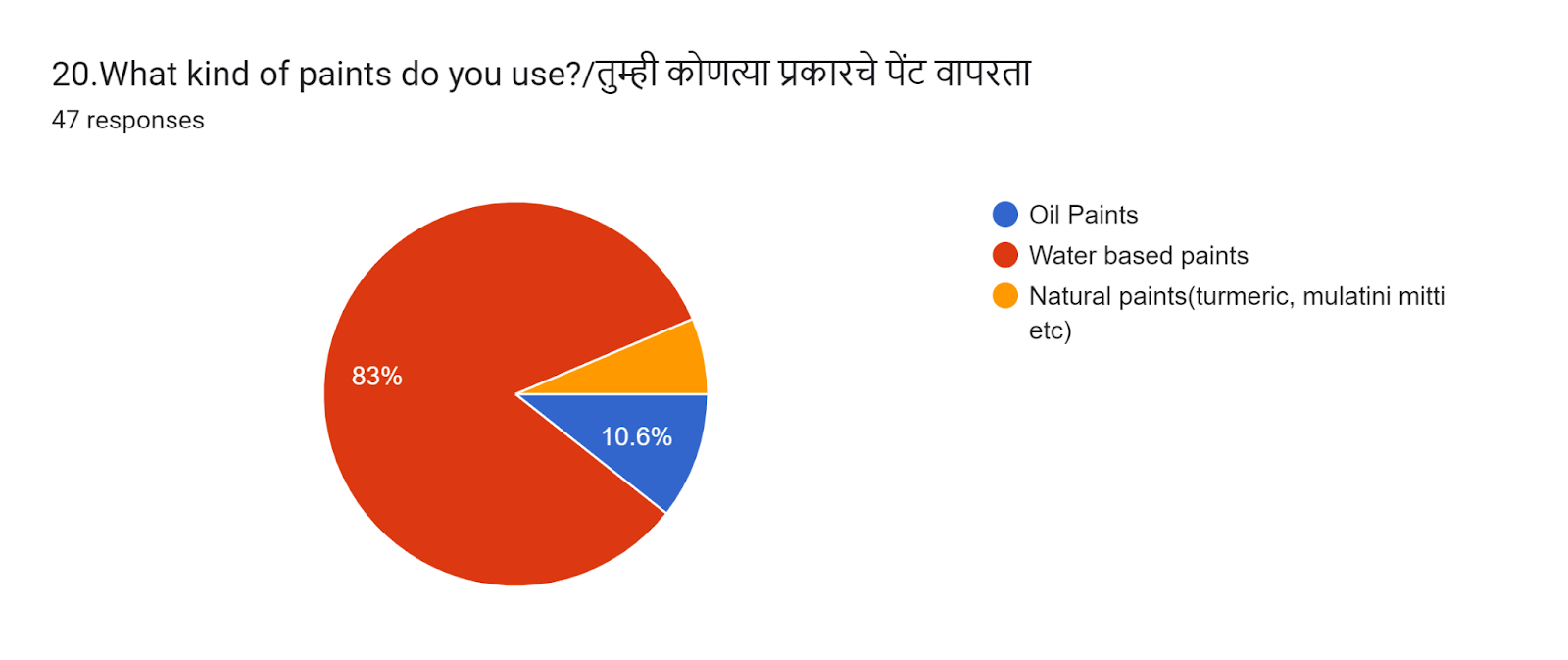
Findings: About 83 percent of artisans use water-based acrylic paints, 10.6 percent use Oil paints, and very few use completely natural paints such as turmeric or Multani mitti.
Q21: Do you think these paints will harm the environment? (47 responses)
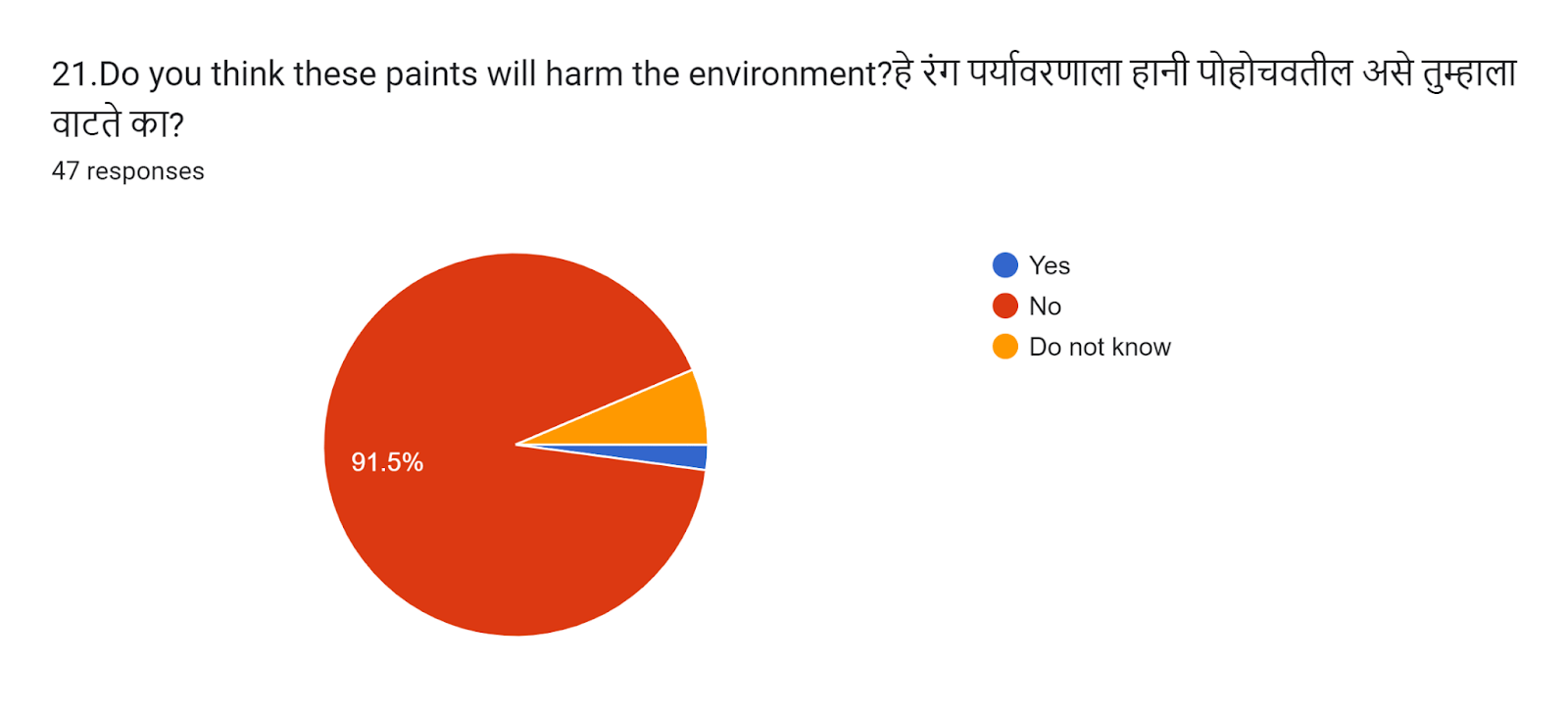
Findings: 37 artisans use Water-based paints and think they will not harm the environment. 5 artisans use Oil Paints, out of which 3 say that Oil paints are safe and 2 do not know. Out of all the artisans, only 3 use natural paints
Q22: If no, why? (39 responses)
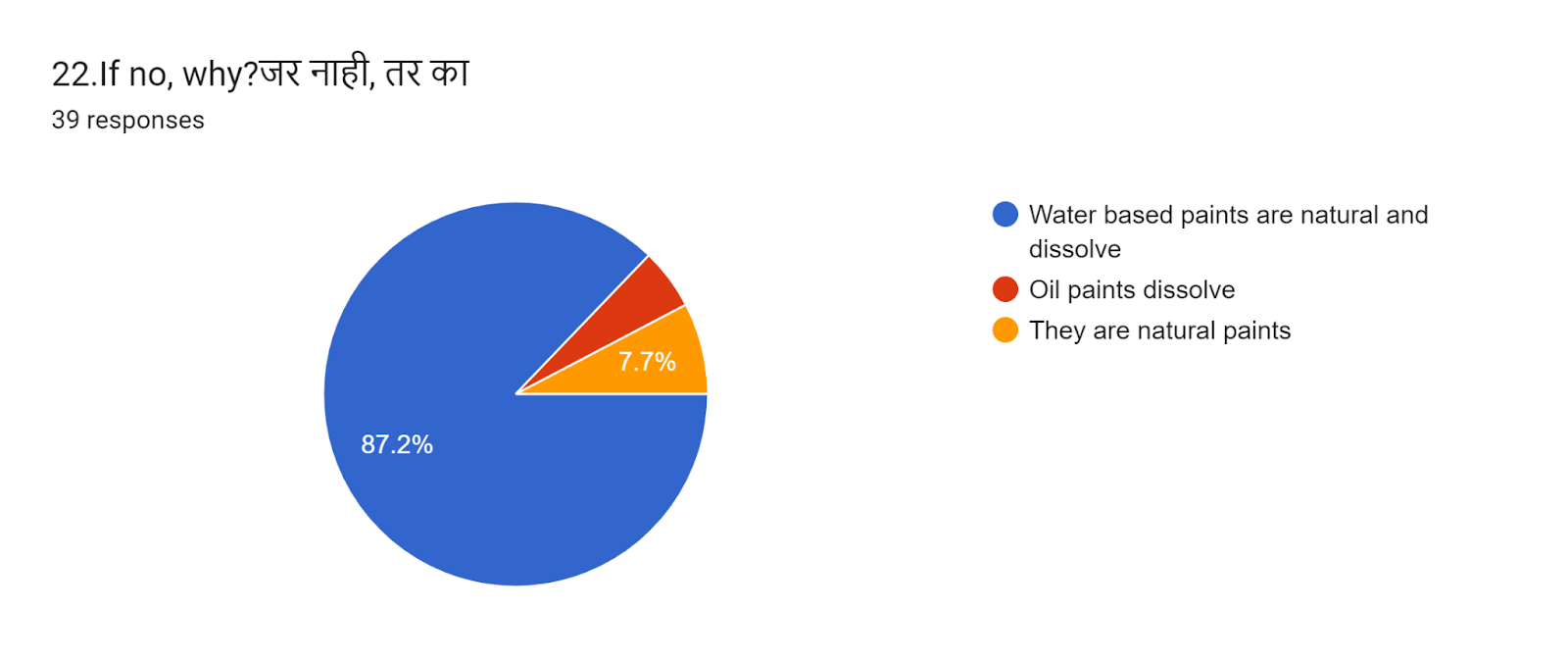
Findings: Another misconception is that since water-based paints dissolve in water, they are natural, and about 87 percent of artisans say this. A small number also believed that oil paints dissolve in water. Those who used natural paints claimed that since they are made from natural materials, they are safe to use.
Notes: The consensus is that as water paints dissolve and are water-based they are safe to use and do not pollute the water. Simply because the effects cannot be seen visually, it is believed to be safe, hence, again, showing a lack of awareness and information.
Q23:Do you know what happens to the idols after immersion? (47 responses)
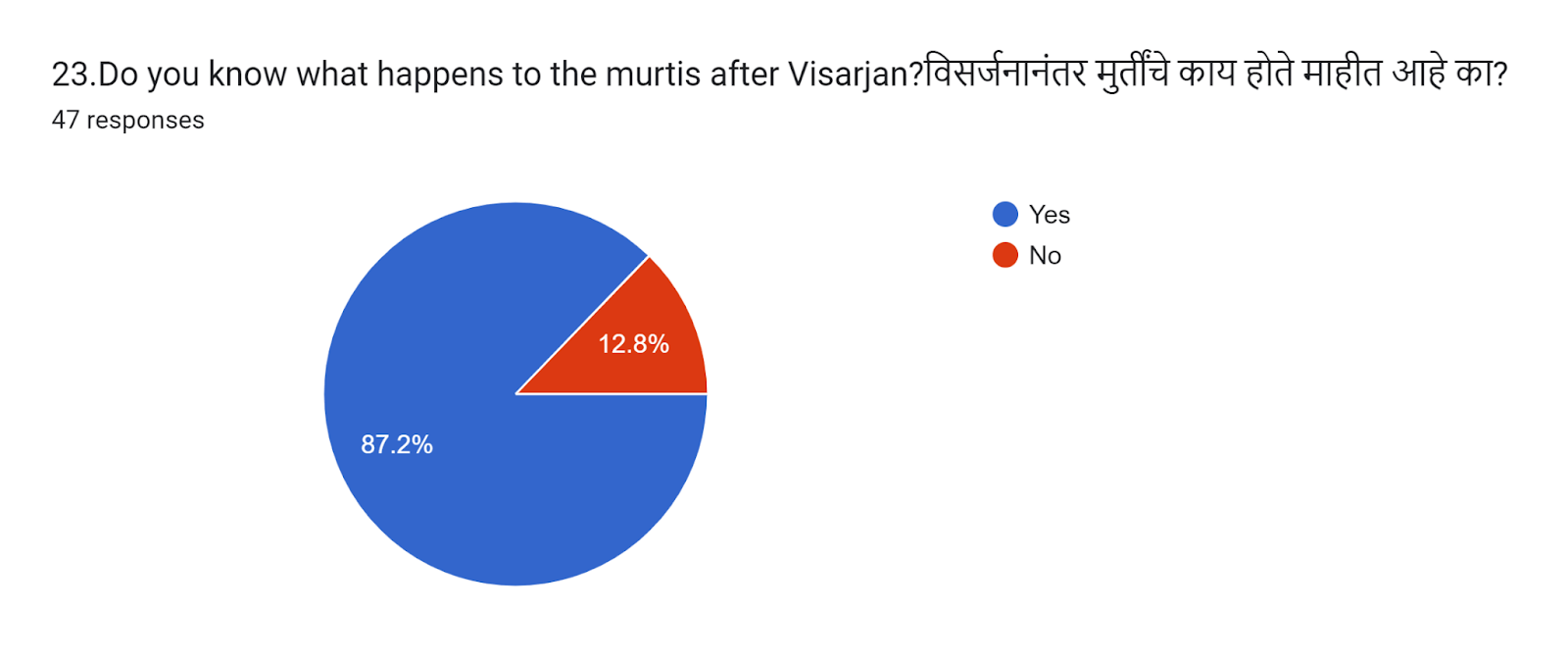
Assumptions: In a linear supply chain, when producers are not held responsible for the ultimate disposal of the product they create, there is little awareness of what happens to the product post-consumer use.
Findings: 87 percent of the artisans, i.e., 41, were aware of what happened once the murtis had gone in the water.
Notes: The question posed was more about what happens to the material substance of the idols – not about the disposal of the material after the immersion.
Q24: Could you elaborate? (37 responses)
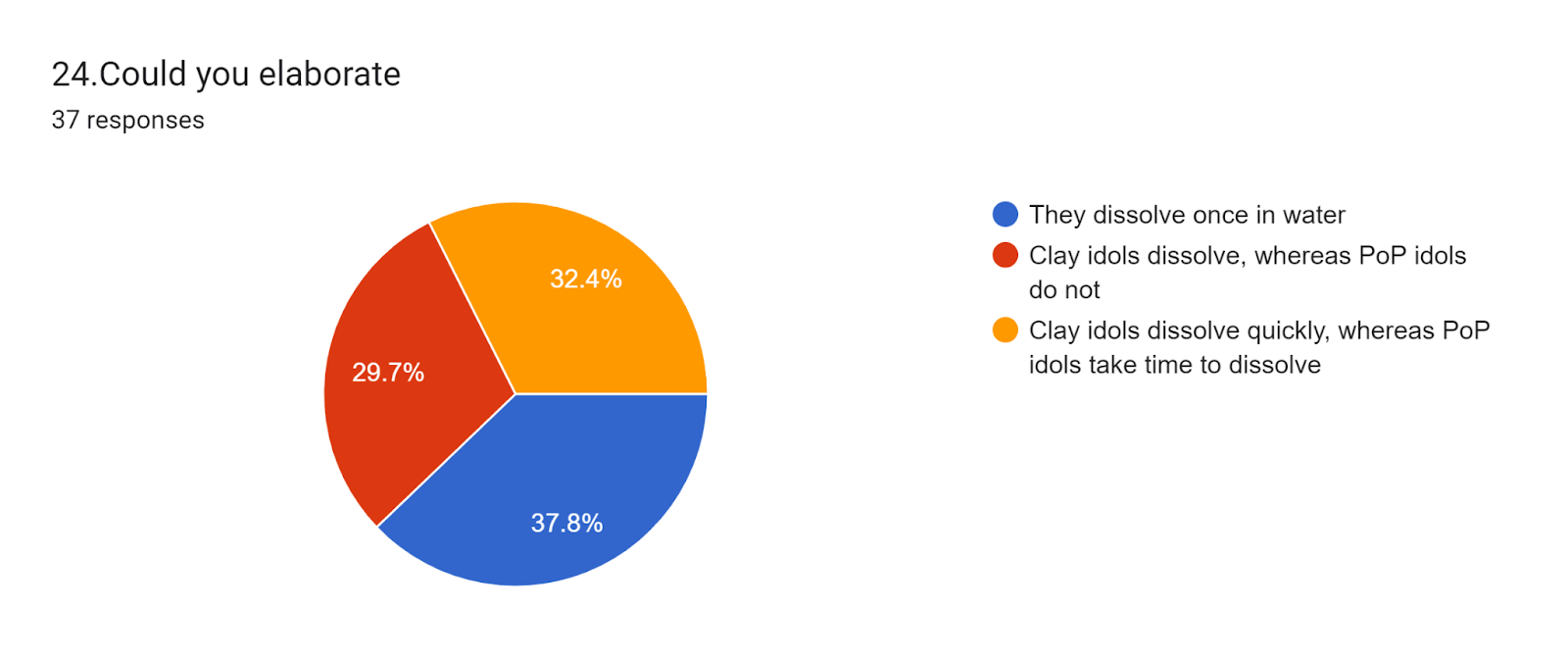
Findings: Out of the 41 who said yes, 11 people believed that clay idols dissolve, whereas PoP idols do not. 12 people said that clay idols dissolve quickly, whereas PoP idols take time to dissolve, and 14 people simply said that all idols dissolve in water.
Notes: The responses were more about how the idol reacts with water but did not elicit responses regarding the ultimate destination of those idols that do not dissolve in water. The rationale that clay dissolves in water was partly used to justify that it was environment friendly and party not. Similarly, the rationale that POP does not dissolve in water was considered an environment-friendly behaviour by some and a polluting aspect by others.
Q25: Are you a part of a union or a sanghatana? (47 responses)
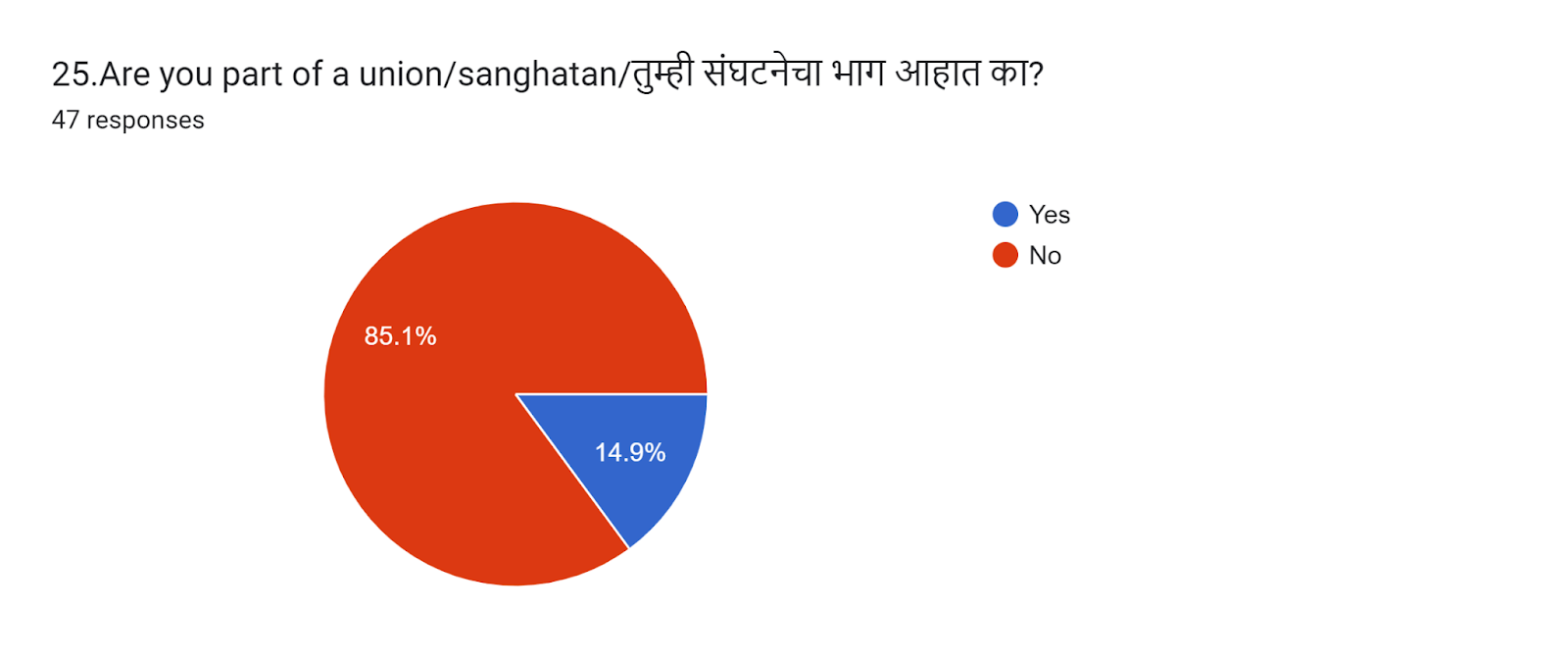
Assumptions: Most of the PILs filed resisting the ban have been done by the Murtikar Sanghatanas and so it was assumed that they are the ones representing the artisans. It was assumed that most artisans are members of the unions.
Findings: 85 percent, that is, 40 people were not part of a union and were independent artisans.
Q26: Has the union reacted to the ban in any ways? (8 responses)
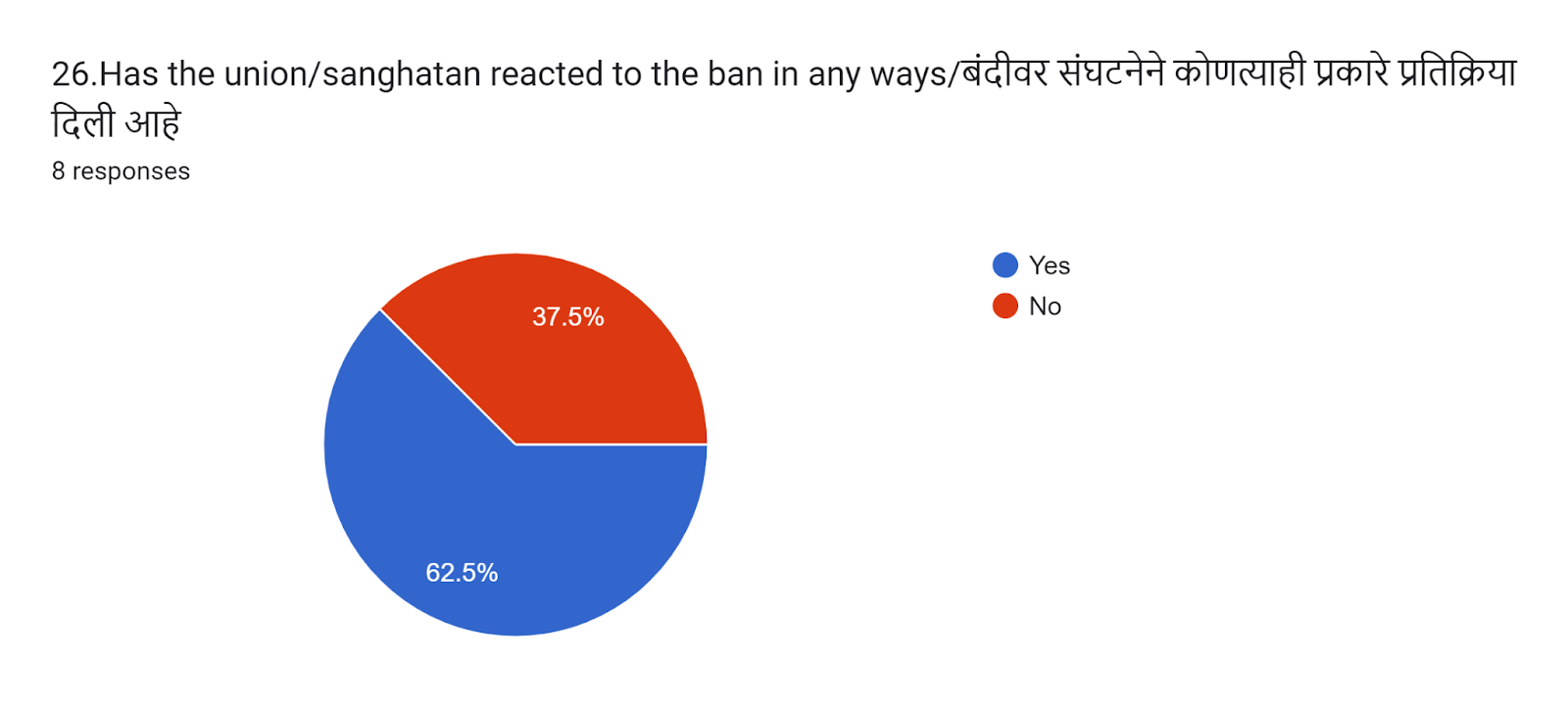
Findings: Out of the 7 who said yes, 5 artisans said their particular unions had reacted to the ban and talked to them about it.
Q27: What steps have they taken? (3 responses)
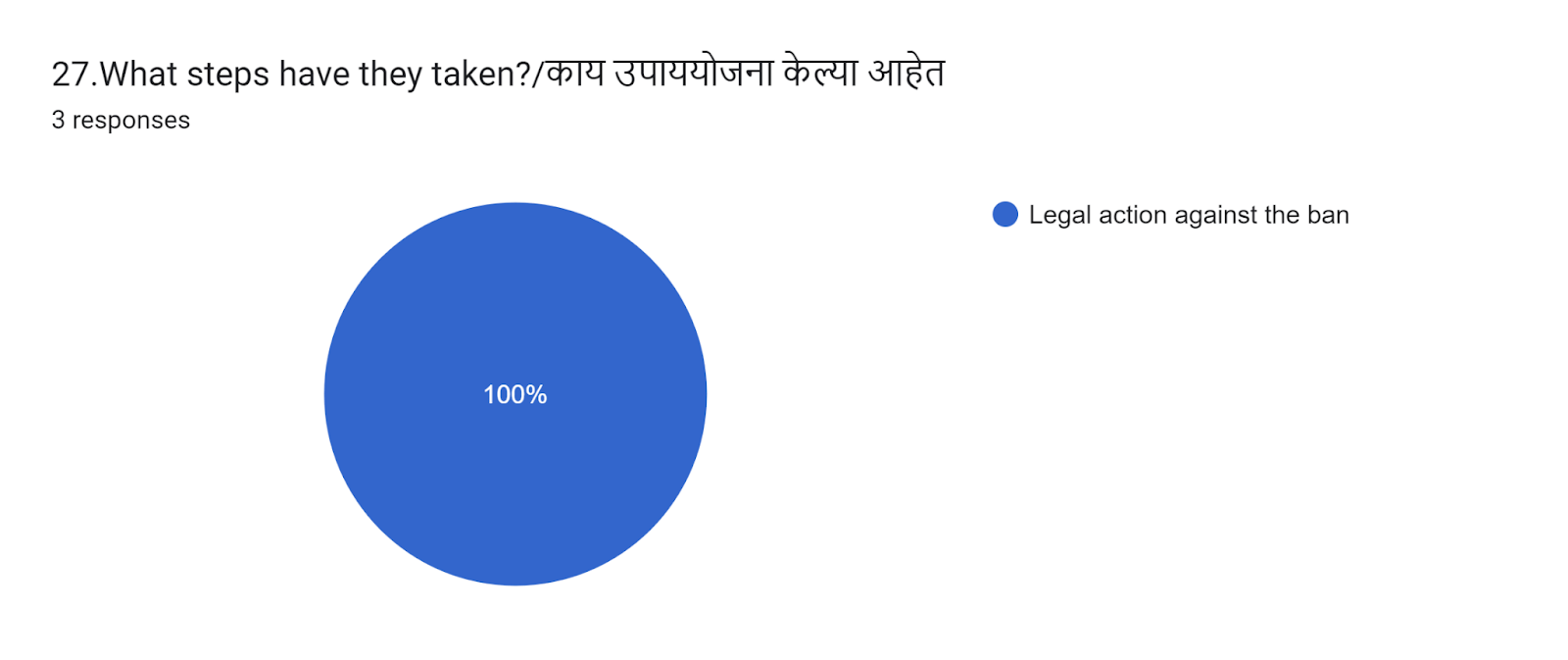
Assumptions: The unions are mainly representing the interests of the artisans. Since they have to represent all artisans no matter which material they use – they are unwilling to take an environmental stand or oppose any one material and promote others.
Findings: The only step taken by the unions was to open court cases and take legal action against the ban while also raising PIL’s.
Notes: To get a buy-in from the artisans it is also necessary that the Unions assist them to shift to newer materials – by giving them access to training and hand-holding in other ways.
Q28: What kind of help do you need from the government? (47 responses)
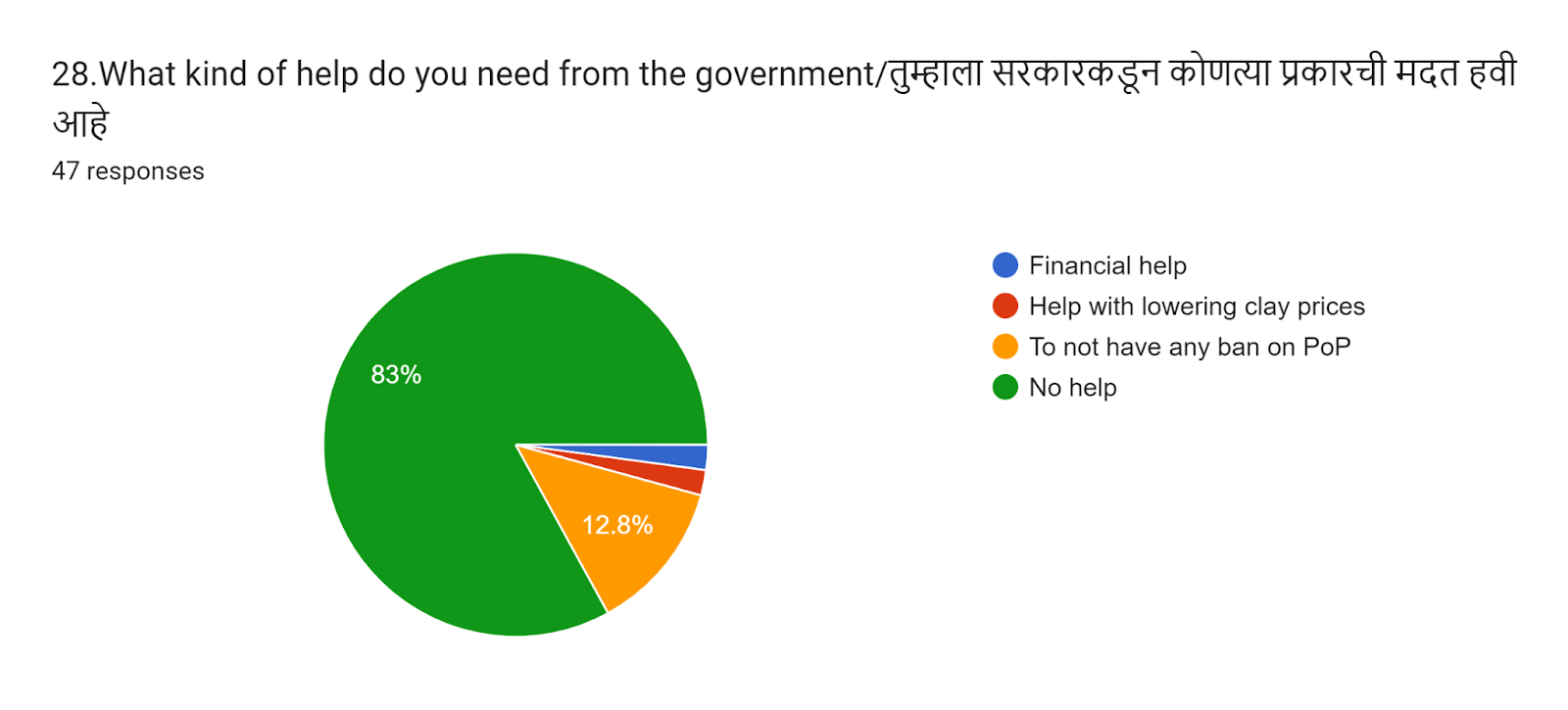
Assumptions: The artisans would be in need of help from the government and would accept any help with open arms.
Findings: The majority of the artisans, about 83 percent of them did not require any help from the government, and others simply asked for there to be no ban on Plaster of Paris.
Notes: There was a large amount of apprehension when it came to the government. A lack of faith towards and help from the government could be noticed and most did not want anything to do with the government and wanted to be left alone. This correlates to question 29, where we can see that the government has not visited the majority of the artisans, therefore not creating any relations with them
Q29. Has the government ever visited you? (47 responses)
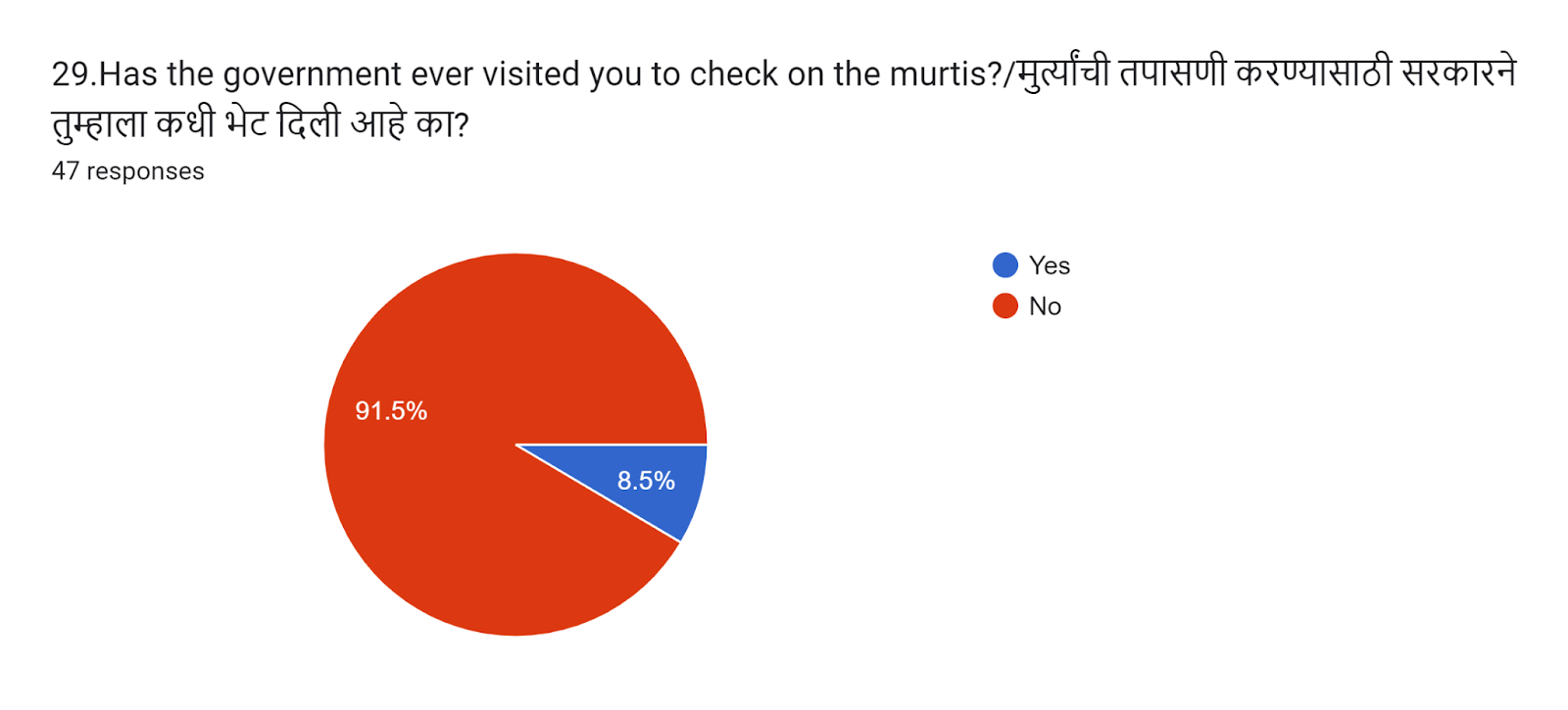
Assumptions: The government would have made checks
Findings: Only 4 artisans out of everyone interviewed had been visited by any body of the government.
Notes: Even though these 4 artisans had been visited by the government, they claimed that there were not any substantial checks made.
Q30. Do you expect the next generations to continue with this work? (47 responses)
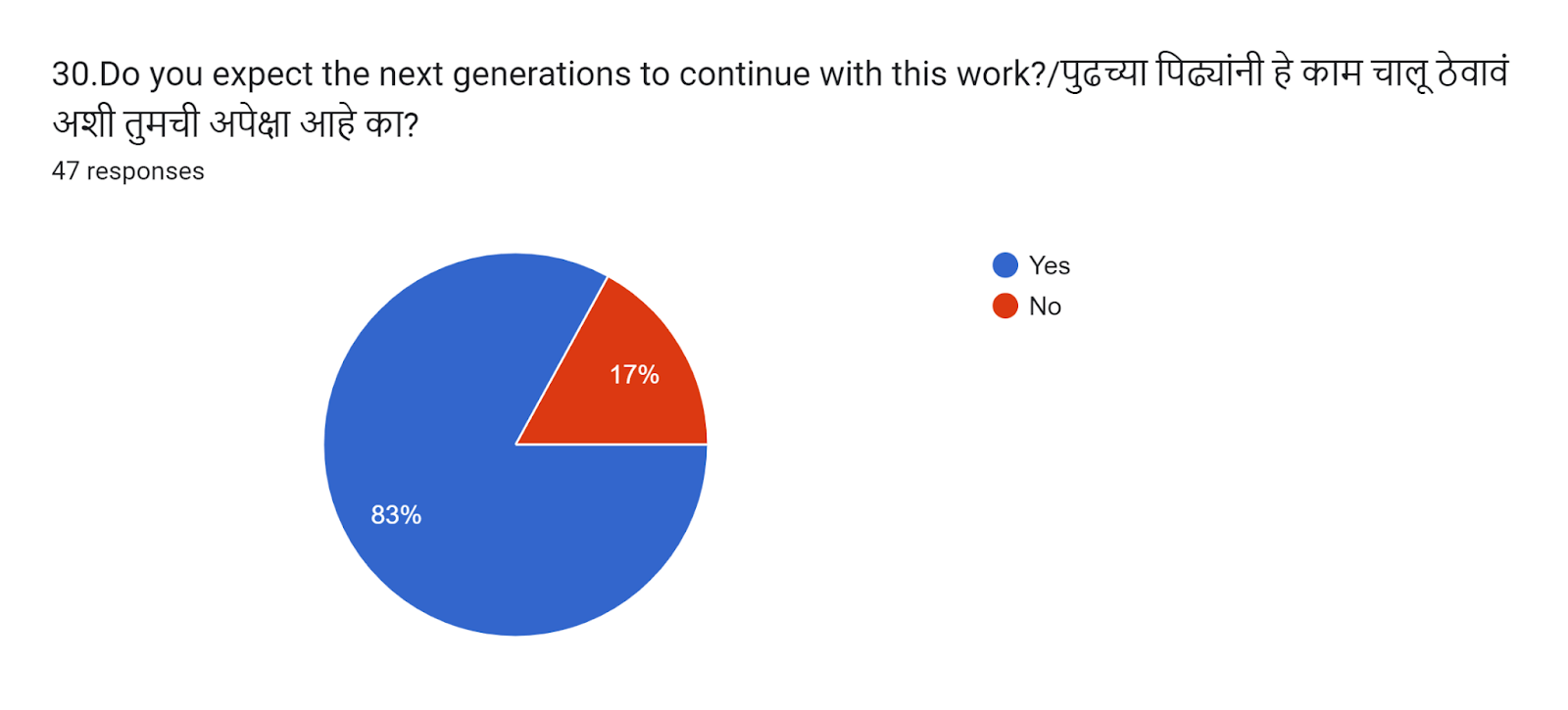
Assumptions: Most people would say no
Findings: 39 artisans believed that the future generations would continue the work of making Ganesh murtis, while 8 did not.
Notes: Those who said that it will continue said that as long as there will be religion and faith, this practice will continue as it is something quite sacred. Those who did not believe in the future if the craft said that the new generations are shifting away from handicrafts. Another point raised was that the instability of this craft as a source of income was driving more and more people away from it.
Conclusions
The findings from the survey were informative and educative, and they contrasted with the assumptions made while heading into the process of drafting the survey. There were many valuable discoveries were made. A deeper understanding from the artisans’ point of view was gained, revealing various new facts.
Firstly, the awareness level of the artisans on topics such as environmental issues regarding to Plaster of Paris, the paints they use, and their consequences came to be known. A general unawareness and, to a point, ignorance of the true effects of PoP was noticed. Artisans claimed that Plaster of Paris was safe for the environment and did not cause harm. A lot of the information on this topic was provided to the artisans by the murtikar sanghatana.
Another important point that came to light was that the demand for Plaster of Paris from the customers was higher. Therefore, the artisans were, in a way, being forced to produce Plaster of Paris idols. Due to the ban, there has also been a rise in clay prices, which has affected the artisans’ ability to use it. A decline in the number of craftsmen who can work with clay has also been noticed.
Refinements
The survey did not take certain aspects into consideration that can be refined in a deeper study.
- The artisanal community is dominated by men however since families are involved in the production the women also have influence over what gets decided. We did not consider gender in this study.
- The size of the idols also changes the production process completely – larger idols for collective use require a different set up than smaller idols meant for home use.
Recommendations
To conclude, essentially, there is a lot of misinformation out there, as well as unawareness among the artisans. There has not been proper dissemination of information on topics relating to the ban, the effects of Plaster of Paris, alternatives to the two dominating materials in the market(PoP and Clay), and a basic understanding of what eco-friendly materials truly are. The government needs to take the initiative to train and increase awareness of artisans.
- As the demand for clay increases with the ban on Plaster of Paris, reuse of the clay can ensure that resources are conserved. The government needs to implement systems of collection and redistribution of the clay after immersion.
- As clay is more labour intensive and labour is getting costlier innovations around mechanisation of certain aspects of the process of sculpting with clay may be considered.
- Subsidies for clay idol production may help the artisans offset the losses they face when working with this material.
- Other newer materials that are natural and biodegradable need to be introduced to the artisans by way of trainings and workshops on alternate materials such as paper mache or cow dung.
- Space and water supply are necessary for working with clay as the idols are to be sundried. Artisans in Pen have a lot more access to space than in Pune. Water supply is unlimited in Pen also. Artisans in larger cities such as Mumbai would definitely find it challenging to switch to clay without such resources.
- Government aid and support not forthcoming results in a mistrust of the government – this needs to be remedied by a closer engagement with the artisanal community. There needs to be efforts to build and sustain relations with the artisans as currently, feelings of apprehension are there towards the government. Regular checks should also be conducted to ensure proper implementation.
- Government support in sales and marketing of eco friendly idols would go a long way in allaying the artisans fear about being unable to market their work.
The government needs to take more initiatives to increase the awareness level of the artisans but also to try and bring a change in the consumers’ mindset, as only when the demand from them stops, will a change be noticed.
Annexure List of Names and Numbers
| 1.Prabhakar Shinde | 9822446308 |
|---|---|
| 2.Shinde | 8856882887 |
| 3.Mahesh Kumbhar | 9822932851 |
| 4. Rohit Kumbhar | 8421704375 |
| 5. Amar Kumbhar | 8237240310 |
| 6. Omkar | 9527549263 |
| 7. Ashish | 8307701530 |
| 8. Rishikesh Yauvle | 9602365371 |
| 9. Alok Shinde | 8975571436 |
| 10. Shital Shinde | 9805073400 |
| 11. Mukesh Kumbhar | 7020982700 |
| 12. Shinde | - |
| 13 | - |
| 14. Sagar Shirke | 9604603412 |
| 15. Deepika Bori | - |
| 16. Subhash Swatikar | - |
| 17. Navnath | 9850230190 |
| 18. Sandeep Wadekar | - |
| 19. Shrikar Shinde | - |
| 20. Keshav Patil | 7387652225 |
| 21. Chandrakar Kumbhar | 9850601857 |
| 22. Avinesh Kumbhar | - |
| 23. Pawar | - |
| 24. Rakesh Khale | 9384279118 |
| 25. Prasad Patil | 8421095276 |
| 26. Sachin Patil | - |
| 27. Avinash Manwankar | 9403012088 |
| 28. Paithankar | 9922229681 |
| 29. Rajesh Gome | 7507100419 |
| 30. Naren Kalenker | 7239122228 |
| 31. Mangesh Pawar | 9850535342 |
| 32. Vicky Sakoskar | 9028029699 |
| 33. Tharibhau Kadu | 7775040668 |
| 34. Ayush Dabade | 7385702784 |
| 35. Sujit Patil | - |
| 36. Subhash Kumbhar | 8446420584 |
| 37. Nilisha Kumbhar | 8788503720 |
| 38. Punekar | - |
| 39. Bhavesh Jadhav | - |
| 40. Nitin Dhanwe | - |
| 41. Prashant | - |
| 42. Ananya | - |
| 43. Chandrakanth Bohir | - |
| 44. Smita Patil | - |
| 45. Vijay Garat | - |
| 46. Prateek Kumbhar | - |
| 47. Yevdekar | - |
Calendar of Visitation Dates
| DATE | AREA | NO. OF ARTISANS SPOKEN TO |
|---|---|---|
| 23/5/2024 | Keshav Nagar, Pune | 6 |
| 28/5/2024 | Keshav Nagar, Pune | 7 |
| 3/6/24 | Keshav Nagar, Pune | 11 |
| 5/4/2023 | Pen | 23 |
Footnotes
- The author is a student at Symbiosis Center for Media and Communications – the survey was conducted as a part of an internship with the eCoexist Foundation. Reach him at [email protected]
- Founder, eCoexist Foundation, [email protected]
- https://www.wisdomlib.org/definition/visarjana
- https://cpcb.nic.in/openpdffile.php?id=TGF0ZXN0RmlsZS8yOTVfMTU4OTI3Mzk4Nl9tZWRpYXBob3RvMjQzNjUucGRm
-
In fact, there is a prevalent confusion about the comparative impacts of clay versus POP even in urban consumers. This is due to a lack of conclusive evidence and also because no one material can fulfill all the necessary environmental criteria.
-
The Polluters Pay principle is an environmental policy concept that holds polluters responsible for the environmental and social costs resulting from their pollution. The idea is that those who cause pollution should bear the costs of cleaning up and mitigating its impacts rather than passing the burden onto society or future generations. It aims to incentivize industries and individuals to adopt cleaner practices and reduce pollution by making them financially accountable for the harm they cause to the environment and public health.